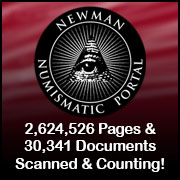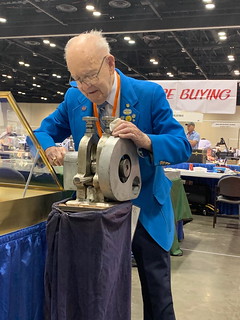
About UsThe Numismatic Bibliomania Society is a non-profit association devoted to the study and enjoyment of numismatic literature. For more information please see our web site at coinbooks.org SubscriptionsThose wishing to become new E-Sylum subscribers (or wishing to Unsubscribe) can go to the following web page link MembershipThere is a membership application available on the web site Membership Application To join, print the application and return it with your check to the address printed on the application. Print/Digital membership is $40 to addresses in the U.S., and $60 elsewhere. A digital-only membership is available for $25. For those without web access, write to: Charles Heck, Treasurer
AsylumFor Asylum mailing address changes and other membership questions, contact Chuck at this email address: treasurer@coinbooks.org SubmissionsTo submit items for publication in The E-Sylum, write to the Editor at this address: whomren@gmail.com BUY THE BOOK BEFORE THE COINSale Calendar
|
- WAYNE'S WORDS: THE E-SYLUM MARCH 15, 2020
- NEW BOOK: 2021 OFFICIAL RED BOOK
- NEW BOOK: BRITISH COINS MARKET VALUES 2020
- NEW BOOKS: THE LIBERTY DOLLAR
- NEW BOOK: THE BANK WAR AND THE PARTISAN PRESS
- UPDATE: THE TEN CASH COMMENTARY
- RAYMOND W. DILLARD (1925-2020)
- MORE ON ANA LIBRARIAN NANCY GREEN
- U.S. MINT CIRCULARS ON NEWMAN PORTAL
- VIDEO: LONG BEACH PCGS SET REGISTRY
- CORONAVIRUS COMES FOR THE COIN SHOWS
- NOTES FROM E-SYLUM READERS: MARCH 15, 2020
- REDUCTION MACHINES AT THE U.S. MINT
- VOCABULARY TERM: JEWELRY FINISH
- RICHARD HOE LAWRENCE (1858-1936)
- HARVEY STACK'S NUMISMATIC FAMILY, PART 65
- WHEN A PHOTO'S WORTH LESS THAN 1,000 WORDS
- DIGITAL IMAGE EDITING FOR NUMISMATICS:
- 2020 ANA YOUNG NUMISMATIST LITERARY AWARDS
- SELECTIONS FROM DAVISSON'S AUCTION 39
- THE GEORGIA TRUSTEES' GARDEN DOLLAR
- LIFE SAVING BENEVOLENT ASSOCIATION MEDALS
- TENINO IS STILL PRINTING WOODEN MONEY
- THE WATERGATE BANKNOTES
- BANKNOTE OF 2019 NOMINATIONS
- BANKNOTES AND MARIJUANA
- LIBYA'S RIVAL BANKNOTES
- DON'T USE MICROWAVE TO DISINFECT BANKNOTES
- THE FEAR OF VIRUS-TAINTED DOLLARS
- FLORENCE NIGHTINGALE BANKNOTE LAMP ERROR
- BITCOIN PROPAGANDA ART
- LOOSE CHANGE: MARCH 15, 2020
- COINS AND HEALTH
- FEATURED WEB PAGE: CHINESE COINS AND MEDICINE
Click here to access the complete archive a
Click here to unsubscribe (scroll down)
To comment or submit articles, reply to whomren@gmail.com
Content presented in The E-Sylum is not necessarily researched or independently fact-checked, and views expressed do not necessarily represent those of the Numismatic Bibliomania Society.
WAYNE'S WORDS: THE E-SYLUM MARCH 15, 2020
 No new subscribers this week. We now have 6,085 subscribers.
No new subscribers this week. We now have 6,085 subscribers.
Thank you for reading The E-Sylum. If you enjoy it, please send me the email addresses of friends you think may enjoy it as well and I'll send them a subscription (but let me know if they are located in the European Union). Contact me at whomren@gmail.com anytime regarding your subscription, or questions, comments or suggestions about our content.
This week we open with five new books and a free update, two remembrances, updates from the Newman Numismatic Portal, and a summary of numismatic closures due to the coronavirus pandemic.
Other topics this week include U.S. Mint Circulars, ANS Librarian Richard H. Lawrence, numismatic photography, Young Numismatist Literary Awards, the Georgia Trustees' Garden dollar, Life Saving Benevolent Association medals, Tenino's wooden dollars, Bitcoin propaganda art, and Watergate banknotes.
To learn more about the 2021 Red Book, the Liberty Dollar, Ray Dillard, Nancy Green, reduction machines at the U.S. Mint, jewelry finish, the W. Earl Spies Collection, the Charles II Silver pattern broad, the Middlesex Copper Penny, Libya's rival banknotes, Florence Nightingale's lamp, and Eyam's Black Death coins, read on. Have a great week, everyone!
Wayne Homren
Editor, The E-Sylum
NEW BOOK: 2021 OFFICIAL RED BOOK
The new edition of the Red Book is coming April 7, 2020. Here's the press release. -Editor
Best-Selling Annual Guide Prices Nearly 8,000 Items;
Reports Dramatic Market and Hobby Changes;
Covers Circulating, Commemorative, and Bullion Coins
 The 74th edition of the coin-collecting hobby's annual Guide Book of United States Coins (popularly known as the "Red Book") will debut April 7, 2020. The new volume includes
completely updated pricing and auction data reflecting the current market for collectible U.S. coins, along with historical information and guidance on how to build a valuable collection. The Red
Book can be pre-ordered online (including at Whitman.com) in several formats, and after April 7 will be available from booksellers and hobby shops nationwide.
The 74th edition of the coin-collecting hobby's annual Guide Book of United States Coins (popularly known as the "Red Book") will debut April 7, 2020. The new volume includes
completely updated pricing and auction data reflecting the current market for collectible U.S. coins, along with historical information and guidance on how to build a valuable collection. The Red
Book can be pre-ordered online (including at Whitman.com) in several formats, and after April 7 will be available from booksellers and hobby shops nationwide.
Coin collectors have used the Red Book to value their collections since the 1st edition was published in 1946. Senior Editor Jeff Garrett attributes the book's strength to its network of experts. "Whitman relies on a system of more than a hundred professional coin dealers, researchers, and other specialists from around the country," Garrett said. "Their expertise covers every segment of American coinage—not just in accurate real-world pricing, but also in the latest discoveries in numismatic scholarship."
Research Editor Q. David Bowers said, "The Red Book is the one reference I keep handy when buying, selling, or writing about coins. Every year it becomes more valuable for hobbyists and researchers. The 2021 edition is the best yet."
Editor Emeritus Kenneth Bressett noted, "There have been ups and downs in the market over the past twelve months. Studying the Red Book gives smart collectors an understanding of the trends across all U.S. coin series."
The 74th-edition Red Book is 464 pages long and prices nearly 8,000 entries in up to 9 grades each, with more than 32,000 retail valuations in total. Its panel of retail-pricing contributors includes more than 100 active coin dealers and market analysts with decades of experience.
The book covers United States coins from 1792 to date, from half cents to $20 gold double eagles, commemoratives, and bullion, plus earlier coins and tokens that circulated in colonial times. The latest coins from the United States Mint—Lincoln cents, Jefferson nickels, Roosevelt dimes, America the Beautiful quarters, Kennedy half dollars, Native American dollars, American Innovation dollars, commemorative coins, bullion coins, and government-packaged coin sets—are kept up to date. The book also includes error coins, Civil War tokens, Confederate coins, Philippine coins struck under U.S. sovereignty, private and territorial gold pieces, pattern coins, Hawaiian and Puerto Rican coinage, Alaska tokens, So-Called Dollars, special modern gold coins, and other specialized topics.
These are illustrated by 2,000 photographs, including enlarged close-ups of rare and valuable die varieties.
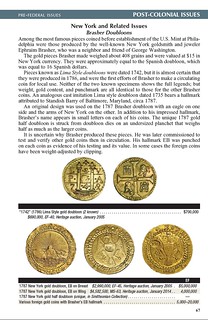
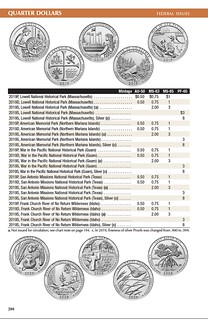
Inside the 74th edition Red Book:
New commemorative coins. The 74th-edition Red Book features coins from the Mint's new 2020 commemorative programs. The Naismith Memorial Basketball Hall of Fame program includes half dollars, silver dollars, and five-dollar gold coins. The Women's Suffrage Centennial program calls for a commemorative silver dollar.
Other new U.S. Mint coins and sets. The 74th edition includes 119 new Mint products added since the 73rd edition. Mintages have been updated across the board using the latest numismatic research and government-supplied data.
Collectors will also find complete coverage of the full range of American Eagle and other popular bullion coins and sets (in silver, gold, platinum, and palladium), with mintages and values for each.
A study of foreign coins that circulated in America. The 74th edition continues a section that debuted with the 70th: an overview of foreign coins that circulated as legal tender in the British American colonies and in the United States until the late 1850s. This section includes photographs, history, and pricing for collectible Spanish-American, Dutch, French, and English coins dating from the 1550s to the 1820s.
Recent research and the latest Mint data. Updates based on recent scholarship can be found in sections including pre-federal coins and tokens, Heraldic Eagle Bust dollars, and California fractional gold. Modern-coin updates include new information on the 2019 and 2020 West Point cents and nickels; the Mint's change from .900 fine to .999 fine silver; the American Innovation dollar program; American Palladium Eagles; the new George H.W. Bush Presidential dollar; and updates to all ongoing Mint programs.
Auction records. As in past years, collectors benefit from the Red Book's recent auction records provided for significant rare coins. Typeset throughout the charts are nearly 200 notable auction results. Combined with the listed retail prices, the auction data help advanced collectors understand the modern market for high-priced rarities.
In addition, the appendix of the "Top 250 U.S. Coin Prices Realized at Auction" has been fully updated. More than 100 auction sales were higher than $1 million each. The coin at #250, an 1880 Coiled Hair $4 gold Stella, sold for $618,125, which is more than $14,000 higher than last year's coin in that ranking.
A bibliography for further research. In a positive measure of the health of the hobby and ongoing numismatic research, the Red Book's newly revised and updated bibliography includes more than two dozen standard references published over the past five years.
The cover of the spiral-bound 74th edition shows a mix of old and modern American coins: an 1898 Barber half dollar; a 1787 Immunis Columbia copper (bearing the words E PLURIBUS UNUM); and a 1986 Statue of Liberty commemorative half dollar, with sculptor John Mercanti's "A Nation of Immigrants" design.
All versions and formats (hardcover; spiralbound hardcover; spiralbound softcover; and Large Print) of the 74th-edition Red Book will be available online, and at bookstores and hobby shops nationwide.
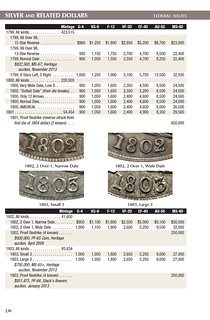
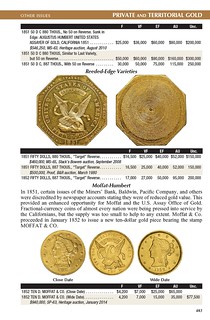
About the Guide Book of United States Coins
A Guide Book of United States Coins is the world's most popular annual retail price guide for U.S. coins, tokens, and other numismatic items. 24 million copies have been purchased since 1946, making it one of the best-selling nonfiction titles in the history of U.S. publishing.
For the 74th edition, more than 100 professional coin dealers, scholars, and other numismatic experts contributed their knowledge under the direction of Senior Editor Jeff Garrett, Research Editor Q. David Bowers, and Editor Emeritus Kenneth Bressett.
The 74th edition of the Red Book is available online and at bookstores and hobby shops nationwide. Whitman Publishing offers a Large Print Edition and several formats of the regular edition (hardcover; spiralbound softcover; and spiralbound hardcover). Details about the forthcoming 1,504-page expanded Deluxe Edition, popularly known as MEGA RED™, will be available soon. For more information and to order, visit Whitman Publishing at www.Whitman.com.
A Guide Book of United States Coins, 74th edition
464 pages
Full color
By R.S. Yeoman; senior editor Jeff Garrett; research editor Q. David Bowers;
editor emeritus Kenneth Bressett.
$15.95 convenient lay-flat spiralbound
$17.95 classic red hardcover
$19.95 spiralbound hardcover
$29.95 Large Print Edition
$49.95 expanded Deluxe Edition (Mega Red) (1,504 pages)

NEW BOOK: BRITISH COINS MARKET VALUES 2020
Trajan Media's Coin and Stamp Supplies is offering a new price guide by Guy Thomas. -Editor
 BRITISH COINS MARKET VALUES 2020
BRITISH COINS MARKET VALUES 2020
$27.95
A Paperback edition by Guy Thomas. The essential guide to over 2,000 years of coins. Now fully in colour, with an indexing system to help you find coins more easily, this is a unique reference book, compiled by market experts and revised annually. With over 100 pages of current market prices, it accurately reflects the state of the market, to help you determine the value of your collection. All your collecting needs are addressed in these pages, including how to keep your coins, where to see the best collections and how to spot a forgery. British Coins Market Values 2020 is a must-buy for any numismatist, whether you are a novice or an expert.
To read the complete article, see:
BRITISH COINS MARKET VALUES 2020 (https://coinstampsupplies.com/product/british-coins-market-values-2020/)
NEW BOOKS: THE LIBERTY DOLLAR
While working on a couple of articles for last week's issue I was reminded of the Liberty Dollar and came across a 2018 Coin World article I'd missed about a book written by Liberty Dollar founder Bernard von NotHaus. Here's some information on that book and another on a related topic. -Editor
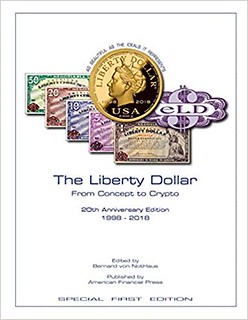
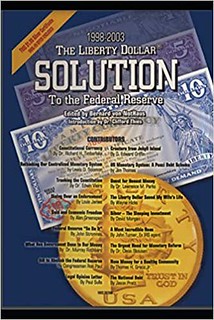
This is the story of the Liberty Dollar and its creator, Bernard von NotHaus. From the ideas that eventually became the now-famous Gold and Silver backed currency that was once touted as giving competition to the Federal Reserve, to the raid that led to the arrest and conviction of Bernard von NotHaus for counterfeiting, even after the government had said for years that the Liberty Dollar violated no laws. This story of faith and triubulation will make your blood boil, but you'll also cheer at the determination that is keeping the movement alive!
For more information, or to order, see:
The Liberty Dollar From Concept To Crypto (https://www.amazon.com/Liberty-Dollar-Concept-Crypto/dp/173104965X)
From 1998 to 2008, the Liberty Dollar brought competition to the Federal Reserve. This was the book that served to guide those who sought a return to Value in Money. Read about the adventures we had in those early days."Just as FedEx brought competition to the US Postal Service and it improved, the Liberty Dollar brings competition to the Federal Reserve!"
That's quite a stretch to call the Liberty Dollar "competition" to the Fed, but private coinage and banknotes had a long history in the U.S. -Editor
For more information, or to order, see:
The Liberty Dollar Solution to the Federal Reserve
(https://www.amazon.com/Liberty-Dollar-Solution-Federal-Reserve/dp/1731047479/)
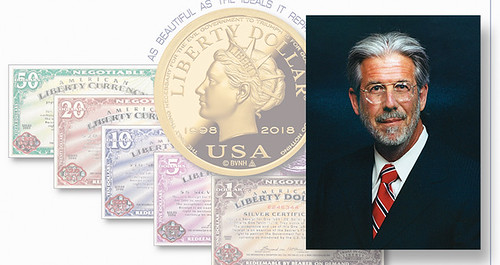
To read the Coin World article, see:
Liberty Dollar creator book details history
(https://www.coinworld.com/news/precious-metals/liberty-dollar-creator-book-details-history.html)
To read the earlier E-Sylum articles, see:
NUMISMAGRAM MEDAL SELECTIONS: MARCH 2020 : Hawai'i. Kalakaua Aluminum Dala Trial Strike
(https://www.coinbooks.org/v23/esylum_v23n10a22.html)
FEATURED WEB SITE: ROYAL HAWAIIAN MINT (https://www.coinbooks.org/v23/esylum_v23n10a28.html)

NEW BOOK: THE BANK WAR AND THE PARTISAN PRESS
Bernie von NotHaus is far from the first to debate the merits of a central banking system in the U.S. The Winter 2020 issue of Financial History (the magazine of the Museum of American Finance) published an article on a new book that banking and currency mavens may find of interest about the bitter partisan fight over the Bank of the United States. Here's an excerpt. -Editor
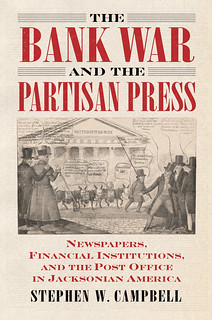 The Bank War and the Partisan Press: Newspapers, Financial Institutions and the Post Office in Jacksonian America
The Bank War and the Partisan Press: Newspapers, Financial Institutions and the Post Office in Jacksonian America
Stephen W. Campbell
University Press of Kansas, 2019
222 pages
Readers who appreciate a new interpretation of a familiar event in America's financial history will welcome The Bank War and the Partisan Press. As noted in the subtitle, Stephen W. Campbell's deeply researched work illuminates the role of newspapers, financial institutions and the US Post Office in the argument over the continued existence of the Second Bank of the United States (BUS).
No author can dispute the outcome of the struggle between President Andrew Jackson and BUS President Nicholas Biddle. But this one views their dueling statements and actions through a different lens than those who have focused only on the differences between those two stubborn men. He supplements the traditional version of the story by delving into each man's use of emerging national institutions to communicate his points of view. Using some unusual aspects of newspapers and the post office, each was able to spread his arguments in favor of— or in opposition to—the re-charter of the BUS to readers and voters across the country. Campbell believes that gaining a better understanding of this "Second Bank War" will enhance our knowledge about both this classic struggle and the widespread contemporaneous conflicts between people with differing views of the government's role in the financial system.
The author devotes a good percentage of his narrative to examinations of both newspapers and the post office in the 1830s. Privately financed newspapers relied on subscriptions and advertising for much of their revenue. Campbell describes how most of them also depended on federal subsidies to make ends meet. Much of that funding consisted of printing contracts from Congress and a variety of executive department agencies.
He also tells how the post office provided newspapers with additional funding. This help took the form of advertisements describing the creation of new postal routes, the extension of the franking privilege to members of Congress, subsidized costs for delivering newspapers and the free exchange of published articles among editors in various locations. That government agency also granted lucrative mail delivery contracts to favored editors and even appointed some of them as postmasters.
Reading that history enables the reader to appreciate more fully Campbell's story of two newspapers that spent much of 1831–1833 endorsing and communicating the arguments against (the Globe) and in support of (the National Intelligencer) the continued existence of the BUS. He presents those papers' interactions with Jackson and Biddle as examples of the intermingling of public and private interests in fostering arrangements that benefitted all parties. Many editors were currying favor with politicians whose ideas they favored; and many politicians responded by enhancing the business opportunities available to those supportive editors.
For more information on the Museum of American Finance, see:
https://www.moaf.org/
For more information, or to order, see:
The Bank War and the Partisan Press (https://kansaspress.ku.edu/978-0-7006-2744-8.html)
UPDATE: THE TEN CASH COMMENTARY
Michael Zachary writes:
"I would like to announce the availability of a free ten-page update to my 2015 guidebook to the general issue ten cash coins of the Republic of China.
 "My guidebook, "The Ten Cash Commentary: The General Issue Ten Cash Coins of the Republic of China," covers 162 varieties issued from 1912 to 1949, with the 2020 update adding 16
additional varieties (and other new information). That compares to the 49 varieties in the Standard Catalog of World Coins and the 125 varieties in A.M. Tracey Woodward's 1936 guidebook to
China's ten cash coins. For example, my guidebook and its update describe through text and photos the six varieties of Y-301, the ten varieties of Y-302, the five varieties of Y-303, and the eighteen
varieties of Y-306.2.
"My guidebook, "The Ten Cash Commentary: The General Issue Ten Cash Coins of the Republic of China," covers 162 varieties issued from 1912 to 1949, with the 2020 update adding 16
additional varieties (and other new information). That compares to the 49 varieties in the Standard Catalog of World Coins and the 125 varieties in A.M. Tracey Woodward's 1936 guidebook to
China's ten cash coins. For example, my guidebook and its update describe through text and photos the six varieties of Y-301, the ten varieties of Y-302, the five varieties of Y-303, and the eighteen
varieties of Y-306.2.
"I am happy to email a copy of the 2020 update to anyone upon request. While it would be most useful to someone who already owns a copy of the 2015 edition, other collectors can use it as a preview of the 2015 edition (which is available through a number of booksellers and Amazon).
"All requests for a copy can be sent to this email address, tencashcommentary@gmail.com "
Here's the information on the book itself and how to order, for those who don't already have one. -Editor
The Ten Cash Commentary: The General Issue Ten Cash Coins of the Republic of China
1st Edition
ISBN-13: 978-1508408215
ISBN-10: 1508408211
The definitive English-language guide to the general issue ten cash and one fen coins of the Republic of China issued 1912 to 1948. Covers 162 varieties, as compared to the 49 varieties in the Standard Catalog of World Coins and the 125 varieties in A.M. Tracey Woodward's guide. Do you have the five varieties of Y-301? The eight varieties of Y-302? The five varieties of Y-303? The sixteen varieties of Y-306.2? The nine varieties of Y-307? Are you confused by the descriptions in the Standard Catalog and Woodward's guide? The detailed text and photographs in this guide, which meticulously describes all of the general issue ten cash and one fen varieties, will end your uncertainty.
To order a copy of the book itself, see:
The Ten Cash Commentary:: The General Issue Ten Cash Coins of the Republic of China 1st Edition
(https://www.amazon.com/Ten-Cash-Commentary-General-Republic/dp/1508408211)
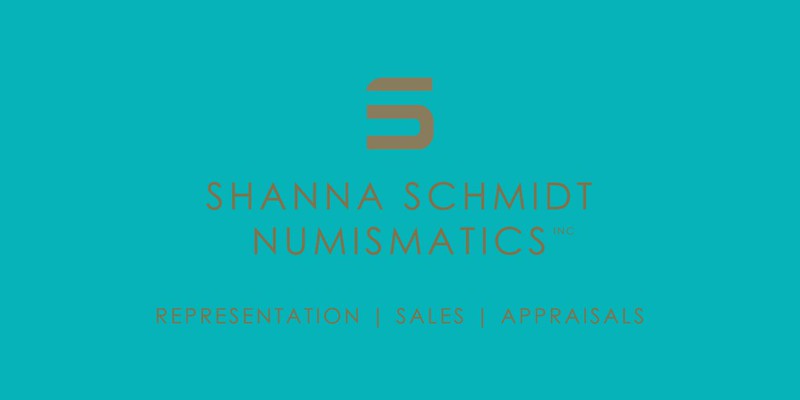
RAYMOND W. DILLARD (1925-2020)
Another U.S. hobby stalwart has passed - elongated cent man Ray Dillard "caught the westbound". Pete Smith passed along a link to his obituary. Ralph Winter and Sandy Pearl passed along a link to his death notice. -Editor
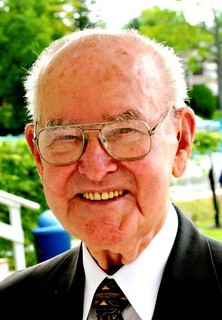 Ray was born on a farm outside of Parma, Missouri July 3, 1925. The son of the late James Monroe Dillard and Sadie Lee (Corlew) Dillard. He was the 10th of 11 children in the family. The
family moved to Flint for the first time in 1929 when he was 3 years old after the family lost the farm in the stock market crash. The family moved back and forth between Flint and Parma depending on
the availability of work. He lived 16 different locations in Flint. The family moved so often that he spent 2 and one half years in the first grade. He would say that he remembered asking his mother
if she thought that I would ever get out of the first grade.
Ray was born on a farm outside of Parma, Missouri July 3, 1925. The son of the late James Monroe Dillard and Sadie Lee (Corlew) Dillard. He was the 10th of 11 children in the family. The
family moved to Flint for the first time in 1929 when he was 3 years old after the family lost the farm in the stock market crash. The family moved back and forth between Flint and Parma depending on
the availability of work. He lived 16 different locations in Flint. The family moved so often that he spent 2 and one half years in the first grade. He would say that he remembered asking his mother
if she thought that I would ever get out of the first grade.
Thanks to summer school he finished high school in 2 1/2 years. He graduated from Central High School, Class of 1943 with his original class. He later attended General Motors Institute and IBM for special courses. Summer school was also where he met his future wife, Elizabeth (Betty) Stirling. They married at age 19 although Ray was only 18 on the marriage certificate, a fact that enjoyed teasing her about for their entire married life. He was a devoted and loving husband to Betty through many years of illness. Betty died on December 13, 2006 after they were married for 62 1/2 years, which was longer than anyone else in the family.
In September 1943, after Ray was rejected for military service, he was hired as office boy at Chevrolet Manufacturing. Following a series of promotions, he was transferred to Chevrolet Central Office and later to General Motors Central Office. Ray retired as Cost Control Administrator (equivalent to Superintendent.) He was responsible for developing the universal coding for all General Motors parts across the various divisions, saving the company millions of dollars. Ray retired after 37 years of service in 1980. Ray was active in the Masonic Order and was a member of many Numismatic Organizations and has attended Numismatic Conventions in every corner of the United States making many, many friends all over the world. Ray kept busy designing and rolling elongated coins for keepsakes and for celebration favors. He even rolled coins for the Australian Olympics in 2000.
To read the complete articles, see:
Raymond W. Dillard (https://www.legacy.com/obituaries/name/raymond-dillard-obituary?pid=195640223)
Raymond W. Dillard (https://www.swartzfuneralhomeinc.com/obituary/raymond-dillard)
"Here is a shot of Ray at this year's FUN. Picture by Cindy Calhoun. Possibly the last "official" photo taken of him doing what he loved best."
A coin show wasn't a coin show for me without saying hello to Ray Dillard. He set up year after years at the PAN shows in Pittsburgh, as well as ANA and other shows. He was already ready with a smile. He will be sorely missed by all. -Editor
THE BOOK BAZARRE
MORE ON ANA LIBRARIAN NANCY GREEN
Pete Smith submitted these thoughts on former ANA Librarian Nancy Green. Thanks! The photo is of Nancy and her son Andy. -Editor
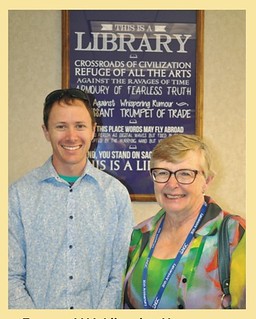 I was saddened to learn of the recent death of Nancy Green. We first met when the ANA convention was in Denver in 1996. She attended the NBS meeting and we talked a few times later in the
convention.
I was saddened to learn of the recent death of Nancy Green. We first met when the ANA convention was in Denver in 1996. She attended the NBS meeting and we talked a few times later in the
convention.
We both had our roots in Minnesota. She attended the University of Minnesota and later worked in the university library. I did not know her then.
I served as president of the Numismatic Bibliomania Society during 2001 to 2007. That nearly coincided with Nancy's second period as ANA Librarian from 2001 to 2008. Thus we had an institutional connection that developed into a strong friendship.
For a few years Nancy and I tried to schedule a lunch or dinner during the ANA conventions. When the convention was in Manhattan in 2002, we had lunch at a nearby cafeteria that sold food by weight.
If you stand on the corner long enough in Times Square, eventually everyone in the world will pass by. As Nancy and I were crossing Broadway back to the convention, we met Wayne Homren coming in the other direction.
In 2003, the convention was in Baltimore. Nancy and I caught a quick supper in the food court of a nearby shopping complex. We hurried back to the convention to watch an auction where the Adams-Carter 1804 dollar was sold.
When the ANA Convention returned to Denver in 2006, Nancy placed an exhibit, "Libraries and Numismatics, Or How One Collector Found a Niche." This earned a second place in the "General or Specialized" Class. More important, she won the award that year as "Best First Time Exhibitor."
I recall that one of her responsibilities at the ANA was to compile the annual index for The Numismatist. So, what do two records management geeks talk about. In some cases they talk about indexing periodicals. That is now a feature I miss in the publication.
After she retired from the ANA the second time, she continued to attend conventions for a few years working as a volunteer at the message center. She moved with her husband to Pagosa Springs, Colorado, and was a volunteer there at the Chimney Rock Archaeological Area for more than twenty years.
She was Nancy Ann West, born in Blackduck, Minnesota, a town of about 750 population, on June 14, 1947. Her father was a staff forester with the Minnesota Department of Natural Resources and her mother was a nurse. She graduated from the University of Minnesota in 1969 with a major in Sociology.
Shortly after graduation, on June 8, 1969, she married John Edward Stith. He had graduated from the University of Minnesota with a degree in Physics. As a 1 st lieutenant, he served in the United States Air Force from 1969 to 1973. His first assignment took the couple to Alaska for a year. Nancy worked there at an early warning radar site.
John Stith was reassigned to Colorado Springs in 1970 to work in the NORAD Cheyenne Mountain Complex. Nancy went on to receive a master's degree in Library Science from the University of Denver in 1975. She began to work at the ANA in 1976 as their cataloguing librarian. She replaced Geneva Karlson as ANA Librarian in 1979 and remained until 1990.
Nancy and John Stith were divorced in 1979. In 1981 she married Ron Green. They had a son, Andrew Wesley Green, who graduated from the California Institute of Technology in 2006 with a degree in astrophysics and worked at the Australian Astronomical Observatory. Nancy died at Saint Mary's hospital in Grand Junction, Colorado, on March 3, 2020.
Howard A. Daniel III writes:
"I was very sorry to read about Nancy Green passing. In the past few years, I have missed seeing her at an ANA Convention with her outstretched arms coming toward me to give me a big hug. She was not only a good friend but also one of several excellent ANA Librarians who have assisted me in my research. The ANA seems to always be able to find excellent people to be their librarians. I am really, really going to miss her!"
To read the earlier E-Sylum article, see:
NANCY GREEN (1947-2020) (https://www.coinbooks.org/v23/esylum_v23n10a12.html)

U.S. MINT CIRCULARS ON NEWMAN PORTAL
The latest additions to the Newman Numismatic Portal are a pair of U.S. Mint Circulars. Project Coordinator Len Augsburger provided the following report. Thanks. -Editor
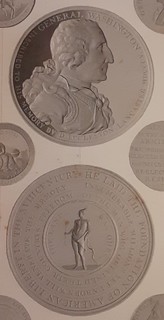 Public statements from the U.S. Mint in the 19th century are few and far between, and most of our knowledge of Mint operations emanates from Mint-internal working documents that were
transferred to the National Archives & Records Administration. However, the Mint occasionally issued circulars that effectively served as press releases or public notices. Newman Portal is
forming a virtual collection of these ephemeral documents, with two recent additions courtesy of Roger Burdette.
Public statements from the U.S. Mint in the 19th century are few and far between, and most of our knowledge of Mint operations emanates from Mint-internal working documents that were
transferred to the National Archives & Records Administration. However, the Mint occasionally issued circulars that effectively served as press releases or public notices. Newman Portal is
forming a virtual collection of these ephemeral documents, with two recent additions courtesy of Roger Burdette.
This pair of 1859 circulars announces the Mint's intention to purchase or trade for Washington pieces lacking in the Mint Cabinet. James R. Snowden, Mint Director, publicized this in May of that year, and in a subsequent December statement withdrew the offer. Snowden's program comes within the context of two publications that served as a catalog of the Mint Cabinet. In 1860 Snowden published an overview of the Mint Cabinet (A Description of Ancient and Modern Coins in the Cabinet Collection) and the following year published the Washington pieces (The Medallic Memorials of Washington in the Mint of the United States). These works represented the first extensive study of the Mint Cabinet (the 1846 Pledges of History is also notable), and were no doubt the impetus for Snowden's solicitation to participate in building what is today the National Numismatic Collection.
Image: Plate 5 from Medallic Memorials of Washington, featuring the Eccleston medal (GW-88)

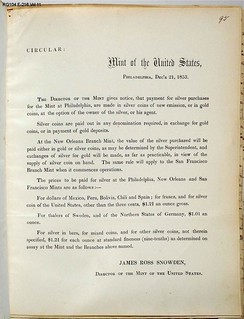
Link to U.S. Mint circulars on Newman Portal:
https://nnp.wustl.edu/library/publisherdetail/534123
Link to James R. Snowden publications on Newman Portal:
https://nnp.wustl.edu/library/booksbyauthor/1816
VIDEO: LONG BEACH PCGS SET REGISTRY
These are selections from the David Lisot Video Library that feature news and personalities from the world of coin collecting. David has been attending coin conventions since 1972 and began
videotaping in 1985. The Newman Numismatic Portal now lists all David's videos on their website at:
https://nnp.wustl.edu/library/multimediadetail/522852
Here's one on the February 2020 Long Beach show. -Editor
COOL! Walkabout the Long Beach Coin Expo February 2020
David Lisot, Narration and Interviewer, Coin Television.com.
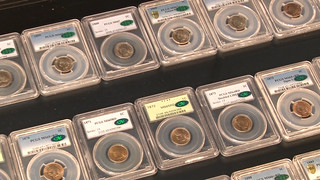
The most important dealers bring their great coins, currency, stamps, sports cards and other collectibles to every Long Beach show. David Lisot of CoinTelevisio walks you around the show and shows you the PCGS Set Registry and the best ever collections of Flying eagle and Indian cents, interviews with David Talk and Stewart Blay, cool toned and variety coins, and interviews with young numismatists Eric Lindholm, CoinScope, Joshua Lockard, Comet Coins, and Wade Spencer.
An excerpt of the video is available for viewing on the Coin Television YouTube Channel at:
https://youtu.be/RKfEzdzs4Lk
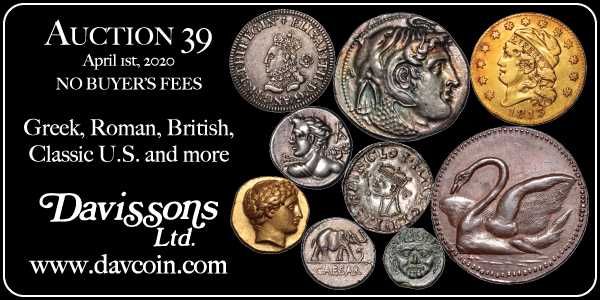
CORONAVIRUS COMES FOR THE COIN SHOWS
The grim reaper waiting in the wings has finally come forth as many feared. While until this week the only coronavirus causualty in the world of numismatics that I was aware of was the postponed Hong Kong show discussed last month. With world events moving rapidly this week, the remaining dominos fell in short order with festivals, sporting events, coin shows and other conferences being cancelled across multiple continents. In the U.S. governors of multiple states shut down large gatherings and closed schools, while the President declared a national emergency and Congress reading spending bills. A March 13, 2020 emailing from David Kahn Rare Coins aptly sums up this week's situation in the world of numismatics. -Editor
We sure hope this note finds you healthy. The current coronavirus situation we find ourselves in is certainly at the top of everyone's list of things to be concerned about, but we wanted to take a moment to make sure you are aware of the fact that the Baltimore coin show, scheduled for next week, has been canceled. Yesterday, Maryland state and local officials ordered that any gathering of over 250 people be canceled, and since the show clearly would have met that threshold, Whitman announced the cancellation. We do not have any current information on a possible re-schedule later in the spring, but that possibility seems very remote. Much more likely is that we will reconvene in Baltimore at the next, regularly scheduled convention in mid-June.
While we at DKRC are currently healthy (and hope to stay that way!), we are also hard at work and have thus far been able to keep the operation in full swing. We intend to continue doing just that. So, while we may all be cooped up more at home in the coming days, we'd like you to consider being a part of our Baltimore Show Replacement Sale. You see, Spring Baltimore is a major part of our gross sales for the year, and generally is our 3rd or 4th busiest show (typically, we do more business at Winter FUN, Summer ANA and Central States, so it may come in 4th, but it can sometimes sneak into the 3rd spot). We're not ready to just give up on those sales. The process to participate couldn't be easier: Find a coin or several on our website that you'd like to own, and give me a call on my cell (240) 793-4680. I'll give you my best price(s). We're going to save the expenses related to doing the show, and we'll be happy to share a large portion of those savings with you. Perhaps in this way we can both win...we'll replace some of our revenue and you'll get great coins at our best possible prices.
We have listed many new coins on the site in the past few days, and more will be coming Monday and continuing well into next week. In fact, I expect over 100 coins back from grading next week (at least 65 to 70 from PCGS and about 40 from CAC), most of which would have gone directly to the show. Now, they will all be listed as fast as possible on the website. Under normal circumstances, newps really aren't discounted, but these aren't normal circumstances. Please check our website often over the next week or two, and give us a call multiple times...we'll be pleased to hear from you as often as you like!
In the meantime, please, take care of yourselves and your loved ones. Be smart, stay healthy and relieve stress by buying some great coins!
We won't rehash all the information you've probably already seen elsewhere, but in the in-case-you-missed-it department, here are excerpts from and links to a number of relevant articles and press releases. -Editor
"The NUMISMATA Munich 2020 has been cancelled!
"Due to new administrative orders of the City of Munich because of the coronavirus, we unfortunately had to cancel the fair at short notice.
"We are deeply sorry that we found ourselves constrained to cancel NUMISMATA at short notice. We apologize to all visitors especially to those who travelled far in order to come to Munich. Nevertheless, we really want to express our gratitude to the many exhibitors who reacted with such an aplomb showing us that they were aware of the difficult situation."
Maryland State of Emergency Forces Whitman Coin & Collectibles Expo to Cancel Bourse

From the American Numismatic Association:
"As things stand today, we are still planning to hold our 2020 Summer Seminar and Pittsburgh World's Fair of Money®. Colorado College has informed us that they are delaying a decision on whether we can hold Summer Seminar on its campus until late April. You can still register for Summer Seminar programs (and we hope that you will); however, during this time of uncertainty, we encourage you to wait to book flights and hotel accommodations until we are confident that the event will be held as scheduled. (Summer Seminar registration fees are fully refundable.) We will keep you updated on the status of both events.
"The ANA headquarters building and Edward C. Rochette Money Museum will be closed to the public from March 14 through April 30, to reduce the spread of Coronavirus."
From the American Numismatic Society:
"First, please know the ANS's work is continuing uninterrupted, as we have instituted contingency plans that were worked out a few weeks ago when the potential extent of the current crisis became clear. While some ANS's staff will be working remotely for as long as is prudent, we expect to be available to you, as always. We have no intention of closing our facilities, but if you are planning to visit, it is important that you check with our staff regarding actual accessibility, which may change based on how the next weeks unfold. If you have questions or concerns, please let us know.
"At the same time, our online presence will continue to improve and expand unabated. The ANS has been at the forefront of digital numismatics for many years now, as can be seen by MANTIS, DONUM, and our successful collaborative platforms, including OCRE, HRC, and CHRR. Beyond our blog, Pocket Change, we are planning to launch a new podcast, The Planchet, covering various numismatic topics. Expect some announcements soon via our e-news and usual social media posts. "
From Shanna Schmidt:
"Hello everyone! I know it may seem like the world has turned upside down but I'm hopeful that people will try to remain calm. I think the self isolation steps that the U.S. has taken is probably the best start to controlling the spread of the virus on the U.S. side. Due to this crisis I was forced to end my Europe trip early by over a week. It was very disappointing not being able to properly view the Roma and Künker auctions but even in the last day I'm feeling much better about the auction situation as the houses are stepping right up with logical solutions.
"To be honest I was most worried about the auction at our good friends at Künker. With the very traditional (and frankly much loved by me) format of floor auctions with no live bidding, came the scary prospect of a lot of missing customers during the auction. Ulrich Künker and his organized staff went into solution mode and decided to offer for the first time live bidding during the auctions. This is a big deal and I commend them for doing this. Phone bidding will still be available and certainly there will be a sizable audience of floor bidders from Europe but having the live bidding option available will open many more opportunities.
"Another auction house that I am quite worried for is Roma. This auction is on the heels of Künker and certainly will experience a lower turnout due to the Coronavirus. Again, Richard Beale and his dependable team have made accomodations for dealers like me. I was able to view some of the coins since I had arrived in England the day when I was forced to change my plans. Viewing some of the coins obviously won't cut it so Richard has made high resolution photographs available to me (and others I'm certain if they request it). Of course it never is as good as being there and viewing them but it certainly is pretty darn close."
From the Central States Numismatic Society:
"The Central States Numismatic Society has canceled its April 22-25, 2020 convention because of the coronavirus outbreak.
"Our focus is the safety and health of our booth holders, exhibitors, collectors and the general public. Therefore, in accordance with recommendations from health officials to cease activities where people gather together in large and close groups, we are canceling our convention," CSNS President Mitch Ernst said.
"The official CSNS convention auctions held by Heritage Auctions will still be held on the dates scheduled. However, the location has changed from the Renaissance Schaumburg Convention Center in suburban Chicago to Heritage's headquarters in Dallas, TX, instead."
From Pete Smith:
"The 2020 Northwest Coin Club Money Show, scheduled for March 20-22, has been cancelled. This would have been the club 86th anniversary show and was to be held at the Earle Brown Heritage Center in Brooklyn Center, Minnesota.
"Friday afternoon, Minnesota Governor Tim Walz issued an emergency order and recommended that all events with attendance of 250 or more should be cancelled or postponed. However, the coin show was cancelled earlier in the day when the venue announced they were cancelling all events from Monday through the end of March.
"This follows the announcement that the Whitman Baltimore show, scheduled for the same weekend, had been canceled based on orders from the Maryland Governor. We expect other coin shows will also be cancelled."
From Paul Schultz:
"The Indiana, PA coin show today (Saturday the 14th) has been cancelled at the last minute. They were going to hold it until they went for setup Friday night and found the building locked. Inquiry led to coronavirus regulations."
From the California State Numismatic Association:
"To all, the Southern Educational Symposium has had to be indefinitely postponed due to concerns about the spread of the COVID19 virus. My intent is still to have the Symposium later in the year at the same location. I will strive to keep everyone informed as to the status of the Symposium and the date of its rescheduling. Thank you for being understanding and I hope everyone keeps safe till then."
"Probably not unexpected, but we wanted to be sure that anyone who had this event on their calendar had sufficient notification to adjust their plans. It would likely be a good tactic to check up on any type of similar event scheduled over the next month or two, just to ensure a likewise postponement or cancellation hasn't been announced. In the meantime, wash your hands, hoard your TP, and stay safe…"
From the Newman Numismatic Portal
"Although Washington University in St. Louis, which administers Newman Portal, has sent students home for the semester, Newman Portal activity continues apace. The campus remains open for staff and faculty, and, while we rely on students to operate scanning equipment, we do have a full-time staff member in St. Louis (Kelli West) to continue handling contributions of hardcopy materials. We also have good options for outsourcing scanning work if necessary. In the meantime, we encourage electronic submissions (documents and images) and can process these virtually. Among the electronic contributors in the last week were Q. David Bowers, Roger Burdette, Richard Lussier, Gerry Tebben, and others. There is no substitute for in-person gatherings of coin collectors, but there is no shortage of research to do on our own, and we hope Newman Portal will help facilitate this as a virtual library.
"Eric Newman once related his experience with the Spanish flu epidemic. Newman, 6 years old at the time, was with his father and sister in New York. The father, a doctor, felt the need to send the two children home to St. Louis. They were cached in a train car, which Dr. Samuel Newman scrubbed down with formaldehyde. The children were instructed not to leave their room until the train arrived in St. Louis. Eric and his sister Ivy, who was four years older, dutifully obeyed, and arrived in St. Louis no worse for wear, despite having inhaled a toxic substance for the better part of a day."
So, what's a collector to do? After taking care of yourself and your family of course, if you find yourself with down time on your hands, what better way to connect and prosper than by going online? In particular, everyone should support their local, state and national numismatic organizations and dealers. So if it's been a while since you've clicked on any E-Sylum ads, give it a try today. Check out new dealer inventory. Pull out some dups to sell. Or email for information about consigning or selling outright an old collection. -Editor
To read the earlier E-Sylum article, see:
2020 HONG KONG SHOW AND SALE POSTPONED (https://www.coinbooks.org/v23/esylum_v23n08a20.html)

NOTES FROM E-SYLUM READERS: MARCH 15, 2020
Subsciber Growth
Jeffrey P. LaPlante writes:
"Congratulations. I just looked and you have over six thousand subscribers, wow, I remember when these numbered in the hundreds, good show !!!"
Thanks. It has been great to see how our community has grown over the years, and it's mostly word of mouth. Please continue to recommend us to your friends and acquaintances in numismatics. -Editor
Christian Finance Association of New York Nickel Album
Dave Lange writes:
"With all of the numismatic society meetings and coin shows being cancelled, it's nice to know that the gathering of minds represented by The E-Sylum continues to appear.
I recently acquired a nice bit of ephemera titled The Nickel Album, but clearly it was not intended for coin collectors. It's actually a book to house nickels solicited as donations to churches or charities. It was published by the Christian Finance Association of New York as a fund-raising tool. From the art nouveau fonts used I date this to the 1890s or very early 1900s. The really interesting thing is that it's not made of the expected cardboard and paper. Instead, both the coin panels and cover are of wood."
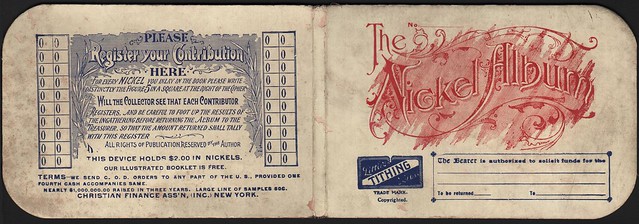
Nickel Album - outside
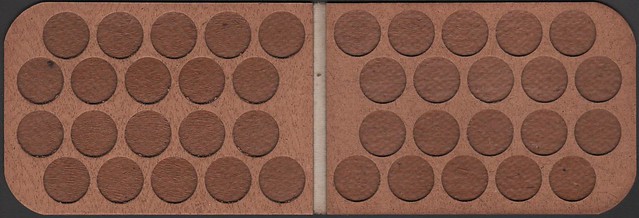
Nickel Album - inside
Thanks! Neat item. -Editor

REDUCTION MACHINES AT THE U.S. MINT
Robert C Whitehead writes:"The article in the last E-Sylum referenced the Janvier Reducing Machine which I believe is still in use today in some quarters because of its accuracy.
In my research I discovered that prior to the Janvier there was the Hill Pantograph, and then before that the Contamin Pantograph."
Here is Robert's writeup on the machines from his detailed web site on the 1881-O Morgan Dollar. Thanks! -Editor
Before the Days of the Pantograph
Before the days of the pantograph the job of the engravers was truly art. A sketch of the coin design was made and then approved by the Director of the Mint. Once approved, the engraver carved the
primary device into the master die by hand.
All dates, stars, and other embellishments were added not to the master die but to the working dies. The addition of these devices so late in the process all but ensured that there would be both errors and die varieties.
This methodology was in place until 1836 when the first Contamin pantograph was purchased for the Philadelphia Mint.
Contamin Pantograph
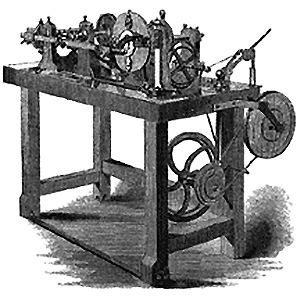 The Contamin Pantograph was in use at the Mint from 1836 to 1867. The first name of Contamin has been lost to history and we have found no source with more detail.
The Contamin Pantograph was in use at the Mint from 1836 to 1867. The first name of Contamin has been lost to history and we have found no source with more detail.
This was the first die-engraving pantograph that used a rotating cutter. This in effect transformed the pantographic into a mechanically controlled milling machine, instead of a copying lathe. The inventor, Contamin (the remainder of his name has been lost to time) was French. Contamin redesigned or adapted an earlier French mechanical pantograph, created by Jean Baptiste Dupeyrat. Contamin's engraving pantograph was in widespread use for over 60 years and its use overlapped the invention of the next generation for years.
Hill Pantograph
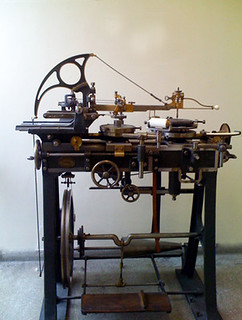 In England machinist C. J. Hill began work on his die-engraving pantograph in the early to mid-1800s. He was possibly inspired by a Contamin, or a reducing machine improved by James Watt at
Soho Mint. After development, Hill sold the rights to his machine to a William Wyon. The Hill machine differs from any others we have seen because it has the galvano and hub laying horizontally
rather than vertically.
In England machinist C. J. Hill began work on his die-engraving pantograph in the early to mid-1800s. He was possibly inspired by a Contamin, or a reducing machine improved by James Watt at
Soho Mint. After development, Hill sold the rights to his machine to a William Wyon. The Hill machine differs from any others we have seen because it has the galvano and hub laying horizontally
rather than vertically.
The U. S. Mint purchased its first Hill pantograph from William Wyon in September of 1867. It was received and placed in use in 1868. However, mint engravers still use the Hill pantograph like they had used their Contamin. Perhaps it was comfort with the old process, but they only used it to make hubs of primary design devices from oversize models. Lettering and numbers were added by hand.
In the 1867 Annual Report Mint Director Henry R. Linderman wrote "this important and interesting machine … reduces copies of bas-reliefs by which the freedom of execution of the larger model is susceptible in the hands of the artist, can be preserved in the most minute proportions … to the face of the coin for which it is designed."
The photograph is from the Royal Mint in Brittan and is the only known picture of this important piece of equipment we have been able to locate. On May 11, 2015 we did receive positive confirmation from a Mint representative that this is the Hill lathe.
Please note that the reducer was treadle powered, making control difficult for the operator and probably requiring some significant skill to master. It has also been reported that the U. S. Mint had their equipment modified, so it likely looked somewhat different. We contacted the U. S. Mint in Philadelphia in May 2015 to see if they have a photograph of their model, but so far there has been no response.
Janvier Pantograph
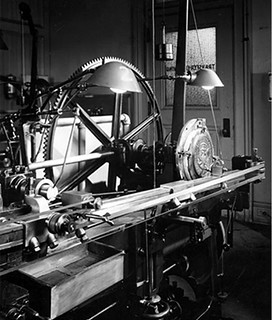 The Philadelphia Mint purchased its first Janvier pantograph at the recommendation and insistence of President Theodore Roosevelt. The President had learned of its existence from sculptor
Augustus Saint-Gaudens. This reduction lathe, or portrait lathe, was the invention of the Frenchman Janvier et Duval.
The Philadelphia Mint purchased its first Janvier pantograph at the recommendation and insistence of President Theodore Roosevelt. The President had learned of its existence from sculptor
Augustus Saint-Gaudens. This reduction lathe, or portrait lathe, was the invention of the Frenchman Janvier et Duval.
Saint-Gaudens model for the high relief $20 gold coin was to be the first American coin reduced on the Janvier machine. Medallic Art founder Henri Weil, who had instructed mint engravers on how the Janvier pantograph was operated. He was later asked by Saint-Gaudens assistant, Henry Hering, for assistance in lowering the relief.
Chief engraver Charles E. Barber declared that Saint-Gaudens' model was still unworkable, the relief was still too high, and it was ultimately lowered for the two varieties of this coin in 1907.
In this video from The Royal Mint there is a Janvier reduction machine briefly shown in use, a rare glimpse into the past. Apparently it was in use for over 100 years.
In the illustration on the left the important features of the machine are evident. The arm with the tracing mechanism on the right and the cutting bit on the left are in their proper place for work. A little more difficult to see, but there, are the belts running across the front. These belts allowed the cutting head more freedom as the design was cut. Since the tracing head was traveling a longer distance as you moved out from the center of the design. The belts allowed for more accurate synchronization between the two heads. This was the improvement over the Hill machine that precipitated the change.
An interesting side note on the Janvier is that it was perhaps too good. Apparently the machine was so accurate and so well made that once acquired it never needed replacing. According to the British Royal Museum the company went out of business for lack of obsolescence. This can be confirmed because we see advertisements for them today some 100 years after their introduction.

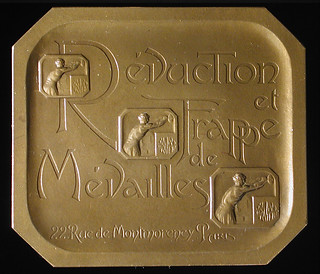
Michael Wehner writes:
"I enjoyed learning more about the Duval Janvier reduction machine. Here is a picture of my example of the medal by Charpentier of the Duval Janvier company. My son, Elliot, also a numismatist, and I were visiting the Metropolitan Museum of Art in New York, when we saw this particular medal in a case. I mentioned that I was thinking about getting one and he asked "How much are they worth?" I replied "Oh about a hundred bucks or so". He answered "Dad, what other piece of art in this museum can you buy for a hundred dollars?" That started a whole collection... "
To read the earlier E-Sylum article, see:
VOCABULARY TERM: JANVIER PANTOGRAPH (https://www.coinbooks.org/v23/esylum_v23n10a17.html)
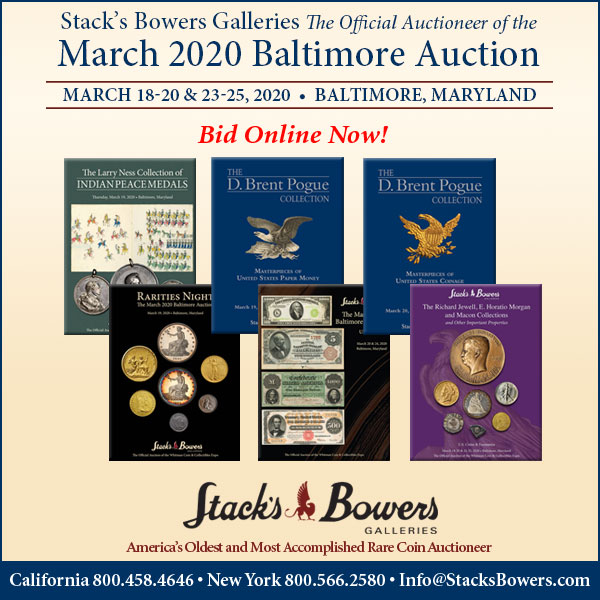
VOCABULARY TERM: JEWELRY FINISH
Dick Johnson submitted this entry from his Encyclopedia of Coin and Medal Terminology. Thanks. -Editor
Jewelry Finish. A surface on medallic items which has been finished by any of several methods commonly employed in the jewelry industry. A common description is "letter tops polished." They are not as satisfactory or as permanent as finishes applied by more standard "medallic" methods. Jewelry finishes usually contain several portions (as lettering, relief or edges) of highly polished areas or brightcut areas often contrasted with satin backgrounds. A typical item might be goldplated, lightly sandblasted to acquire the satin background, then chosen areas highly buffed with jeweler's rouge to obtain the polished surface (bright finish). The process then continues: wash, dry, bake and lacquer.
For large medals, jewelry manufacturers like to polish the edge and often the rims of a medal. This makes the edge smooth (and susceptible for dropping). It is against the rules of standard medal manufacturers who purposefully design the rims and edges for aiding the human fingers to grip the piece more so. The existence of jewelry finish on a medallic item would indicate it was manufactured by a jewelry maker rather than a typical medal manufacturer. See finishing and finishing, brightcut, polished edge.
Looking for the meaning of a numismatic word, or the description of a term? Try the Newman Numismatic Portal's Numismatic Dictionary at: https://nnp.wustl.edu/library/dictionary
Or if you would like a printed copy of the complete Encyclopedia, it is available. There are 1,854 terms, on 678 pages, in The Encyclopedia of Coin and Medal Technology. Even running two a week would require more than 19 years to publish them all. If you would like an advance draft of this vital reference work it may be obtained from the author for your check of $50 sent postpaid. Dick Johnson, 139 Thompson Drive, Torrington, CT 06790.
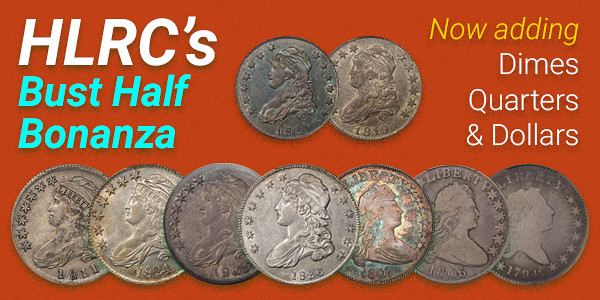
RICHARD HOE LAWRENCE (1858-1936)
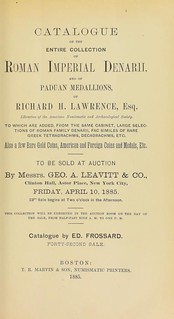 Lawrence, Richard Hoe (1858-1936), Lewisboro, Westchester, New York. 81 Park Avenue, New York. A superlative collector and savant. He was born the first child of Cyrus Jay Lawrence
(1832-1908) and Emily Amelia Hoe (1834-1909), on March 18, 1858. His parents married in 1856.
Lawrence, Richard Hoe (1858-1936), Lewisboro, Westchester, New York. 81 Park Avenue, New York. A superlative collector and savant. He was born the first child of Cyrus Jay Lawrence
(1832-1908) and Emily Amelia Hoe (1834-1909), on March 18, 1858. His parents married in 1856.
His father was a wealthy banker and principal of Lawrence Brothers & Co., and member of the Stock Exchange, numismatist and art collector and about 1887 owner of Cyrus J. Lawrence & Sons.
Cyrus Jay Lawrence was also a numismatist and a member of the American Numismatic and Archaeological Society in New York as well as a member of the Metropolitan Museum of Art, the American Museum of Natural History, the American Archaeological Society, the Bibliographical Society of Boston, the New York and Baltimore Municipal Art Societies, the Grolier Club and the Union League Club. He died January 9, 1908.
His mother was the granddaughter of Richard March Hoe (1812-1886) the inventor of the Hoe printing press, after whom she named her son.
His family lived in Paris from October 5, 1872 until September 30, 1876. He and his brother Henry Corbin Lawrence (1859-1919), were educated at Paris, France and upon returning home 1876 and 1877 respectively joined their father's firm, Cyrus J. Lawrence & Sons.
Among his passions were collecting of all kinds especially numismatics, books, art and journaling these activities through scrapbooking and photography. This passion for collecting was the result of his family's influence having avid collectors of books, art and coins on both his mother's and father's family. As an amateur photographer he was an assistant to Jacob Riis (1849-1914). His artistic flare was towards social realism of the 1880's sympathetic with Riis' muckraking by documenting through photographing raw scenes of the social derelicts and decadence of the City of New York foreshadowing the avant-garde that later came with the New York Ash Can School.
As a specialist in numismatics he focused on the coinages of the Roman Republic and Early Imperial periods. He was a patron of the ANS in 1906. As an aficionado of art he was a member of the Society of Iconophiles formed in 1895 for the purpose of issuing engraved views of New York City. During his tenure with the Society he served as its president and issued a publication of its History. As a bibliophile he was a member of the Grolier Club.
He traveled abroad and stayed in Paris, France during the summer of 1888. He married Jessie Cort (1868-1949), on April 19, 1897 at Manhattan, New York.
He was an active life member of the ANS since November 19, 1878. He was a member of the Executive Committee, ANS and served as a Vice-President. A donor, in 1878, to the ANS library he became the Librarian from 1880-1886. During his tenure as ANS Librarian he produced the "First Acquisition Ledger" giving an account of the collection with author names, titles of works, donors names, and so forth.
His collection of 581 lots was sold at auction by Ed Frossard on April 10, 1885 at George A. Leavitt & Co., New York. See Adams, Vol. 1 : 72, Sale 42, C+; Durst 874
The ANS owns two scrapbooks (1859-1907) relating to his coin and medal collecting and scrapbooking activities focusing on numismatics comprising newspaper and magazine clippings.
To read the complete article, see:
LAWRENCE, RICHARD HOE
(https://sites.google.com/site/numismaticmallcom/encyclopedic-dictionary-of-numismatic-biographies/lawrence-richard-hoe)

HARVEY STACK'S NUMISMATIC FAMILY, PART 65
The latest article in Harvey Stack's blog series is about the Stack firm's auction sales of 1974. Thanks, Harvey. -Editor

Meanwhile, our business of presenting auctions and serving our clients continued. Some collectors had decided that 1974 was a year to sell, and our Public Auction program brought some great collections to market. In the early part of the year, we offered more of the collection formed by the famous Adams Family to benefit the Massachusetts Historical Society. A little more than 1,700 lots were sold to help the Society raise funds to preserve the historical documents that were in their museum.
In March 1974 we offered the Estate of Phillip Spiers, a comprehensive collection of coins and paper money of the United States. April brought our sale of Part 2 of the Albert Globus Collection of Gold Coins of the World, a prize winning cabinet.
In May and June we sold several smaller collections of high quality which offered many scarce pieces. Our September sale featured items from the Estate of S.G. Steckler, who had been a client of Stack's for over three decades. Featured were many early United States Proofs from 1858 through modern times.
November brought our catalog of the Henry C. Gibson Collection of United States Gold Coins. This cabinet featured a vast and almost complete offering of the standard issues of Pioneer and Territorial gold coins, many acquired from our prior sales, such as the George Walton Collection. There were also rare dates and quality pieces of all denominations of United States gold coins. On the following day, we offered a selection of colonial coins called the Donald Grove Collection, a pseudonym for Donald Partrick that he asked us to use so that few would know that he was selling some of his vast collection. Even though most were duplicates of his primary collection, they were of very high quality and rarity and attracted very enthusiastic bidding.
In December of 1974, we were privileged to catalog and sell the W. Earl Spies Collection of Early U.S. Silver Dollars from 1794 to 1803. This comprised most of the varieties listed in Bolender's specialized reference book Early Silver Dollars 1794 to 1803. This was among the most complete offerings of early silver dollars to come on to the market in many decades. Attendance at the sale was astounding as specialized collectors from all over the country flocked to the Auction to acquire some of the great rare varieties that Mr. Spies had assembled.
So as discussed above, 1974 was a hectic year. We had great auctions, we helped with the challenge faced by the Smithsonian and the Mint wishing to mount coin exhibits for the Bicentennial and, sadly, we lost a great member of Stack's, my uncle Joseph B. Stack. As my father, Morton had passed away seven years earlier, we were fortunate that my son Larry had entered the firm. With Larry on board, we continued to have family members who were dedicated to helping our clients, as well as our dedicated staff of superb numismatists to back us up. We were able to keep Stack's at the forefront as a leader in numismatics.
To read the complete article, see:
Harvey Stack Remembers: Growing up in a Numismatic Family, Part 65
(https://www.stacksbowers.com/News/Pages/Blogs.aspx?ArticleID=Harvey-Stack-Remembers-Part-65)
To read the earlier E-Sylum article, see:
HARVEY STACK'S NUMISMATIC FAMILY, PART 64 (https://www.coinbooks.org/v23/esylum_v23n09a15.html)

WHEN A PHOTO'S WORTH LESS THAN 1,000 WORDS
Martin Kaplan passed along this recent post on coin photography by Douglas Winter Numismatics photographer Jenna Van Valen. It's an update of a piece written in 2014. Here's an excerpt - see the complete article and photo examples online. -Editor
We've all heard the numismatic mantra, "Buy the coin, not the holder." But what about those times we can't view the coin in person? Surely we can't all attend every convention, every auction, visit every dealer and view their inventory. We rely on dealers we trust, we rely on their descriptions, and we hope that the photo tells enough of a story that we can make an informed opinion on the coin without actually holding it in our own hands. We need to count on the dealer to be our eyes, because no two photos of the same coin will look the same. Why?
It's quite simple, really. When we hold a coin, we can tilt it, put it under different lighting conditions, get a feel for the overall look of the piece. But when I photograph a coin, I have to give you a quality representation of all the aspects of a coin under various conditions in one image. I can neither deceptively hide the flaws, nor do I really want to highlight them unless they're dreadfully apparent in hand. It's a balancing act, not so much science as intuition from nearly two decades as a professional photographer (eek, hello 40!), and taking into account the literally tens of thousands of coins I've photographed and handled in the last decade+ in numismatics. It's entirely, completely, and sometimes woefully, subjective.
To prove my point, I spent a few extra minutes photographing a coin we purchased for inventory, using different lighting conditions, and different post-processing techniques. I will explain each set of images in non-photo-nerd terms.
The first example is my standard photograph, this is what I would post on our website as an inventory photo. I won't go into proprietary details, but I use a copy stand, an electronic cable release, some lamps, a fantastic lens, and a nice DSLR body. I currently use Photoshop CS5 for my post-processing, and have a predetermined white balance and set of techniques I use on every image to ensure consistency.
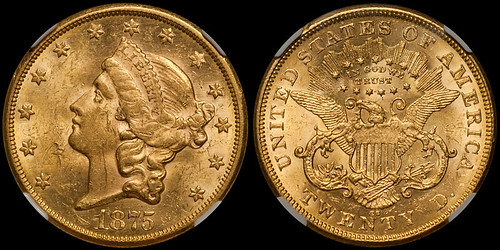
1875-CC NGC MS61 WITH MY "STANDARD" EDITS
But wait - here is the same exact photo. I'm not kidding - it's the same photo, with different processing applied. But I used the same image files to produce this result. I could email the original files to 10 different Photoshop nerds, and you'd get back 10 different results, all based on our own intuition, experience, and techniques.
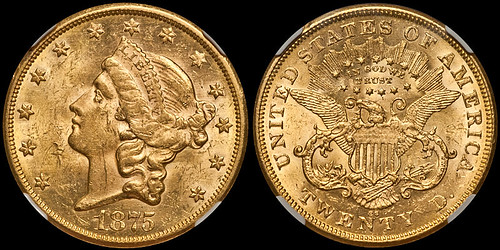
1875-CC $20.00 NGC MS61, SAME FILES, DIFFERENT PROCESSING
And it is so very, very simple to take the same exact coin, on the same exact copy stand and lens, and without even moving my lights or adjusting exposure, completely change the end result. I took these three obverse photos at all the same settings, processed them identically, and yet we have three wildly different results. Why? I simply rotated the coin so that it faced my light source at a different angle/rotation. It was literally just a slight turn to the left, dead center, and then to the right. Same coin, same distance, same lights, same processing, different rotations.
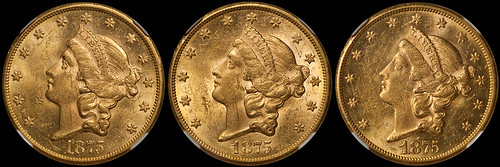
1875-CC $20.00 NGC MS61, THREE DIFFERENT ROTATIONS
I strongly encourage collectors to remember this, and remember it well: A photo can be worth 1,000 words, but is it the right story?
To read the complete article, see:
A Photo is Worth 1,000 Words (Except When It's Not Enough)
(https://raregoldcoins.com/blog/market-blog/a-photo-is-worth-1000-words-except-when-its-not-enough)

DIGITAL IMAGE EDITING FOR NUMISMATICS:
To learn about numismatic digital image editing, consider attending the mini-seminar by Michael Kodysz at this year's ANA Summer Seminar. -Editor
 Digital Image Editing for Numismatics: Getting Your Obverses & Reverses Together is a new six-hour mini-seminar offered by the American Numismatic Association at the 2020 Summer
Seminar in Colorado Springs. The mini-seminar course will cover the basics of digital image editing for collectors, dealers, authors, and researchers. While the course is geared primarily toward
novices unfamiliar with the relevant software, all experience levels are welcome.
Digital Image Editing for Numismatics: Getting Your Obverses & Reverses Together is a new six-hour mini-seminar offered by the American Numismatic Association at the 2020 Summer
Seminar in Colorado Springs. The mini-seminar course will cover the basics of digital image editing for collectors, dealers, authors, and researchers. While the course is geared primarily toward
novices unfamiliar with the relevant software, all experience levels are welcome.
Attendees will learn how to organize, edit, and modify coin and paper money images for the purposes of print and web publishing, cataloging, personal reference, and exhibiting. Topics covered will include an overview of software options and the basics of Adobe Photoshop®; best practices for file organization, formatting, and image resolution; and a discussion of ethical guidelines. Demonstrations will include the basics of color correction, how to add or remove backgrounds from images, and how to create special effects such as drop shadows and reflections. Students will gain hands-on practice in combining separate obverse and reverse photos of the same coin into a single seamless composite image. It is recommended that students bring their own digital images for hands-on practice, but practice images will also be provided by the instructor. It is highly recommended that students bring their own laptop with bring their own laptop with Adobe Photoshop® to familiarize themselves with the software.
Skills in digital image editing are essential for anyone interested in digital numismatic photography. The mini-seminar is held on Monday and Tuesday evenings during Week II of Summer Seminar, so it can be taken in conjunction with the Advanced Digital Numismatic Photography for Collectors course held during the day.
INSTRUCTOR: Michael Kodysz, visual communication instructor and numismatic exhibitor
Session Two – Sun & Mon, July 5 & 6 Two Nights – 6 hours total
3 hours each night (6:30-9:30 p.m.)
Here are some examples of the types of things students will learn to do:


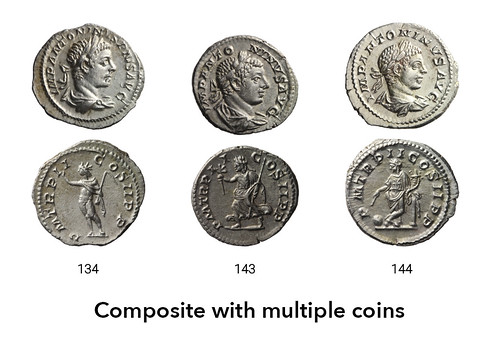

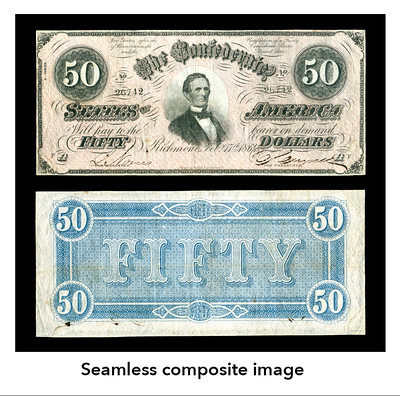
For more information, or to register for the Summer Seminar, see:
ANA SUMMER SEMINAR 2020 (https://www.money.org/summer-seminar)

2020 ANA YOUNG NUMISMATIST LITERARY AWARDS
The ANA is accepting submissions for its 2020 Young Numismatist Literary Awards. Here's the press release. -Editor
 Submissions for the American Numismatic Association's (ANA) annual Young Numismatist Literary Awards competition are being accepted through April 1. The awards were established to
encourage young writers and promote future numismatic authors and researchers. The contest is open to young writers in three age groups, all of whom will compete for cash awards and numismatic
books.
Submissions for the American Numismatic Association's (ANA) annual Young Numismatist Literary Awards competition are being accepted through April 1. The awards were established to
encourage young writers and promote future numismatic authors and researchers. The contest is open to young writers in three age groups, all of whom will compete for cash awards and numismatic
books.
Article submissions will be evaluated by a panel of judges, including Bill Fivaz, Q. David Bowers and Kenneth Bressett. Awards will be presented in Colorado Springs at the ANA's 2020 Summer Seminar in June. Those who are unable to attend will receive their awards by mail.
Eligibility
To compete in this year's competition, participants must be ANA members. Submitted articles will focus on a numismatic topic of the competitor's choice.
Bill Fivaz Young Numismatist Literary Award
Ages: 8-12
Article should display basic knowledge of a numismatic topic. Creativity and original conclusions are encouraged.
Suggested length: 450-900 words
Q. David Bowers Young Numismatist Literary Award
Ages: 13-17
Article should display advanced knowledge of a numismatic topic. Logically presented facts and original conclusions are encouraged. A bibliographic list of sources is recommended, but not required.
Suggested length: 900-1,800 words
Kenneth E. Bressett Young Numismatist Literary Award
Ages: 18-22
Article should display in-depth knowledge of a numismatic topic. Logically presented facts and original conclusions are required, as is a bibliographic list of sources. Inclusion of charts, graphs,
tables or other illustrations is encouraged.
Suggested length: 1,800-3,600 words
Award Structure
The following prizes will be awarded in each of the three age categories:
• First Place: Certificate and $500 cash prize, plus a $500 voucher to help build a personal library of numismatic books produced by Whitman Publishing.
• Second Place: Certificate, plus a $200 book voucher from Whitman Publishing.
• Third Place: Certificate, plus a $100 book voucher from Whitman Publishing.
Completed entries should be emailed to magazine@money.org or sent to:
ANA Publications Department
818 N. Cascade Avenue
Colorado Springs, CO 80903-3279
For additional information, please contact magazine@money.org.

SELECTIONS FROM DAVISSON'S AUCTION 39
Here are some selected lots from the Davisson's auction closing April 1, 2020. -Editor
Lot 1: KINGS OF MACEDON. Philip II Stater
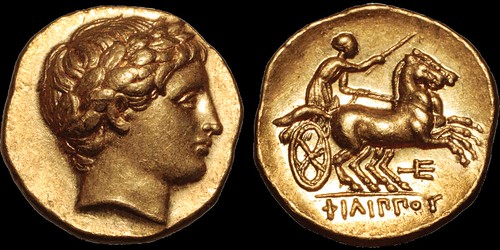
KINGS OF MACEDON. Philip II. 359-336 B.C. AV stater. 8.63 gm. 18 mm. Amphipolis mint. Struck under Antipater, Polyperchon, or Kassander, circa 323-315 B.C. Laureate head of Apollo right / Charioteer driving biga right, holding kentron and reins; trident below horses; ΦΙΛΙΠΠΟΥ in exergue. Le Rider 223 (D99/R176). SNG ANS 269 (same reverse die). HGC 3.1 847. Extremely Fine; well centered; high relief strike with mint luster. Exceptional coin.
Ex Davissons Auction 19 (1 May 2003) lot 1
Love the charioteer! -Editor
To read the complete lot description, see:
Printed Auction 39 Lot 1 (https://davcoin.com/lot/printed-auction-39-lot-1)
Lot 25: BRUTTIUM. Kaulonia. Stater
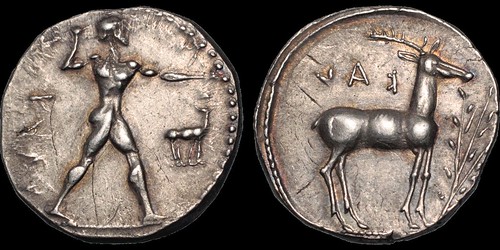
BRUTTIUM. Kaulonia. Circa 475-425 B.C. AR stater. 8.01 gm. 20 mm. Apollo, nude, his hair bound with a taenia, advancing right, holding laurel branch in his upraised right hand, small daimon running to right on his outstretched left arm; to left, ΚΑVΛ (retrograde) downwards; to right, small stag standing right, head left / Stag standing right; ΚΑV (retrograde) above, laurel branch to right. HN Italy 2046. Noe, Caulonia Group F, 98 (same dies). Extremely Fine; light attractive tone with hints of iridescence; well centered; struck from a slightly worn obverse die
Very stylized images - I like the style. -Editor
To read the complete lot description, see:
Printed Auction 39 Lot 25 (https://davcoin.com/lot/printed-auction-39-lot-25)
Lot 98: ANGLO-SAXON. Harold II. Penny

ANGLO-SAXON. Harold II. 1066. AR PAX penny. 1.37 gm. 20 mm. York mint, Sutere moneyer. His crowned bust left with scepter / PAX across center; +S (retrograde)VTERE ON EOFFR. S. 1186. N. 836. Extremely Fine; fresh surfaces; superb coin.
Ex William J. Conte Collection (CNG Triton VI, 13 January 2003, lot 1479)
Another primitive style. Check out Harold's neck - just a few lines. -Editor
To read the complete lot description, see:
Printed Auction 39 Lot 98 (https://davcoin.com/lot/printed-auction-39-lot-98)
Lot 112: Charles II Silver pattern broad
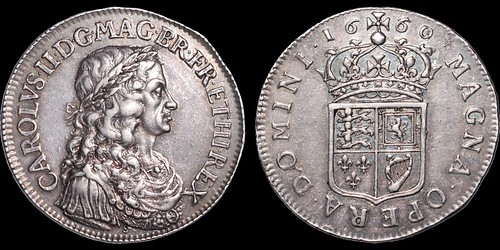
Charles II, Restoration. 1660-1685. Silver pattern broad. 8.25 gm. 28.5 mm. By Thomas Simon. 1660. Laureate bust of the King right; CAROLVS II D G MAG BRI FR ET HI REX around, S under the bust (Simon) / Crowned square-topped shield; MAGNA OPERA DOMINI around. S. -. N. 2776. Carter type II (BNJ 20). Extremely Fine; attractive old toning, underlying luster particularly in legends and reverse devices.
Ex CNG Sale 36 (5-6 December 1995) lot 1545.
Thomas Simon produced five different varieties of patterns for broads (20 shillings). All were produced with a mill and screw press.
Nice coin. -Editor
To read the complete lot description, see:
Printed Auction 39 Lot 112 (https://davcoin.com/lot/printed-auction-39-lot-112)
Lot 196: 1797 Middlesex Copper Penny
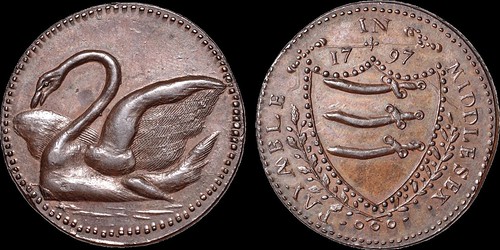
Middlesex 174 (RR). Miscellaneous Series. Copper penny. 24.3 gm. 35 mm. By Denton. 1797. A swan, in high relief, swimming left / Three swords in a shield, laurel and oak sprigs beside; 1797 above; PAYABLE IN MIDDLESEX around. Edge: I PROMISE TO PAY ON DEMAND THE BEARER ONE PENNY. Good Extremely Fine+; attractive brown tone; some light die flaws (as usual with this piece); a centerpiece for a token collection.
The Mike Sussman Collection of British Trade Tokens
Ex McKivor who notes on envelope: "AU. No rub but some weakness in strike…"
Great piece - a classic rarity for the Conder token series. Love the swan. -Editor
To read the complete lot description, see:
Printed Auction 39 Lot 196 ( https://davcoin.com/lot/printed-auction-39-lot-196)
Lot 318: Vermont Landscape Copper
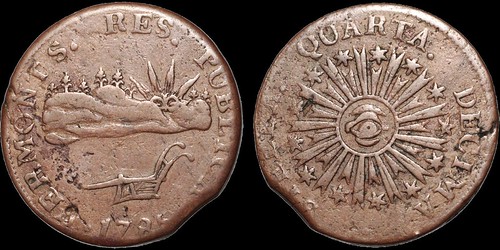
UNITED STATES. Post-Colonial. Vermont. Copper. 9.64 gm. 26.5 mm. 149 grains. 1785. "Landscape" variety; VERMONTS RES PUBLICA 1785 / Double rays and stars around a central eye; STELLA, QUARTA. DECIMA. Carlotto RR-2. Bressett 1-A. Very Fine; early strike before die break; pleasant surfaces; minor flan flaws and a slight clip; overall an attractive example.
Purchased from C. Victor-McCawley (tag included).
I've always enjoyed the Vermont landscapes, but never owned one. Decent piece. -Editor
To read the complete lot description, see:
Printed Auction 39 Lot 318 (https://davcoin.com/lot/printed-auction-39-lot-318)
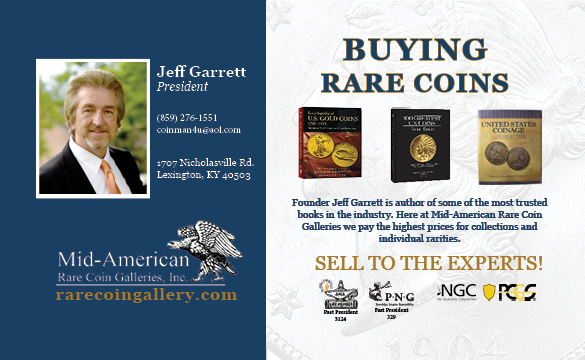
THE GEORGIA TRUSTEES' GARDEN DOLLAR
The Effingham Herald of Rincon, GA published an article about the local connection to the new Georgia Trustees' Garden dollar coin. -Editor
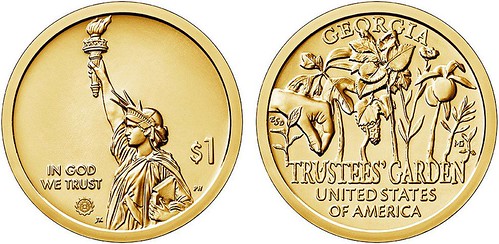
The first in a series of coins celebrating American innovation was released recently by the United States Mint and the Georgia $1 coin features Trustees' Garden in Savannah. Trustees' Garden is owned by Charles Morris, the president and CEO of Savannah-based Morris Multimedia, which owns the Effingham Herald.
"I do think it is very appropriate for Trustees' Garden to be recognized with a coin," Morris said. "After all, Savannah is the mother city of Georgia, the last of the 13 original colonies."
The American Innovation series is a multi-year initiative by the Mint to honor innovators and innovations from each state, the District of Columbia, and the five U.S. territories — Puerto Rico, Guam, American Samoa, U.S. Virgin Islands and Northern Mariana Islands. The 2019-dated coins represent Delaware, Pennsylvania, New Jersey and Georgia.
Four new $1 coins with distinctive designs will be released each year from 2019 through 2032 in the order the states ratified the Constitution of the United States or were admitted to the Union, said Michael White with the US Mint's Office of Communications. On Jan. 2, 1788, Georgia became the fourth state to ratify the Constitution, which is why it was among the first four coins to be released.
Morris said he was unaware Trustees' Garden would be included in the coin series and only found out a few weeks ago when his daughter let him know.
"It does amaze me that I own a piece of property, really a piece of history, with a national coin named for it," Morris said. "It is very humbling and a great honor."
Trustees' Garden was established in the 1730s as the first agricultural experimental garden in America. The Garden employed a botanist to collect seeds, drugs and dyestuff from other countries with a similar climate to conduct research on how they could be grown in Georgia.
White said the Mint worked with the Georgia governor's office to develop the concept for the coin.
The Trustees' Garden part of the coin was designed by Emily Damstra, a freelance illustrator who creates zoological, botanical, anthropological, ecological and paleontological illustrations. She has designed three coins for the U.S. Mint, more than a dozen coins for the Royal Canadian Mint and a few postage stamps for the United Nations Postal Administration.
The coin's design depicts a hand planting seeds in the inscription "TRUSTEES' GARDEN," from which grows a variety of species representing the variety of plants grown in the garden: an orange tree seedling, sassafras, grapes, white mulberry, flax, peaches, olive, and a young shoot that is too small to be identified.
The additional inscriptions are "UNITED STATES OF AMERICA" and "GEORGIA."
The other side features a dramatic representation of the Statue of Liberty in profile with the inscriptions "IN GOD WE TRUST" and "$1." The side also includes a privy mark of a stylized gear, representing industry and innovation. "2019", the mint mark, and the inscription "E PLURIBUS UNUM" are engraved on the edge of the coin.
To read the complete article, see:
Herald owner's property honored by U.S. Mint
(https://www.effinghamherald.net/local/herald-owners-property-honored-us-mint/)

LIFE SAVING BENEVOLENT ASSOCIATION MEDALS
Dave Baldwin recently revised the Life Saving Benevolent Association medals page on his George H. Lovett web site. Here's an excerpt and a couple examples. Nice medal. -Editor
The years 1838 to 1849 saw 338 shipwrecks along the coast of New Jersey and Long Island; in response to this a group of merchants, ship-owners and other private citizens formed the Lifesaving Benevolent Association of New York. The purpose of the organization as stated in the original charter is to "recognize and reward courage, skill and seamanship in the rescue of human life on the sea or any navigable waters … to encourage training in seamanship, lifeboat work, methods of rescue in the water, and the resuscitation of victims of submersion.". Working with the newly established U.S. Lifesaving Service they helped construct and operate life-saving stations along the New York Coastline.
In 1915 the Federal government took control of the stations and they eventually became the responsibility of the U.S. Coast Guard. The LSBA continued to reward individuals with monetary compensation, pins and medals to recognize heroism at sea. In 2009 the Seamen's Church Institute took on the administrative duties of the LSBA.
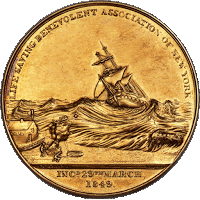
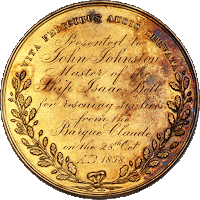
1858 Award Medal Presented to John Johnston
At first glance it would appear that there is just two dies - one obverse and one reverse. On closer examination it seems there are two reverse dies and two obverse dies. The reverse dies differ in the design of the wreath. The obverse dies differ in the composition of the waves, the design details on the ship, and other small details as well as having the lettering "sculp" to the right on the exergue line.
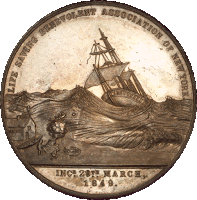

(image courtesy of The Newman Numismatic Portal - Alan Weinberg Collection)
Dave adds:
"I would like to find out if anyone has examples of these medals with different combinations of dies, or completely different dies."
To read the complete article, see:
Life Saving Benevolent Association of New York (http://ghlovett.blogspot.com/p/life-saving.html)
THE BOOK BAZARRE
TENINO IS STILL PRINTING WOODEN MONEY
Found via News & Notes Volume V, Number 38, March 10, 2020 from the Society of Paper Money Collectors. -Editor
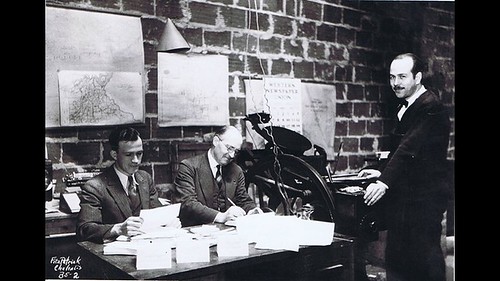
For more than 20 years, Loren Ackerman has been making money the old fashioned way, by printing it himself.
At the Old Tenino Depot Museum, he uses the same 1890 Chandler & Price press that once printed the local paper.
This is the machine that saved Tenino in its darkest days.
"They were closing doors and locking things up and they had to come up with something to keep the town alive," says Ackerman.
To understand the story we have to go back 90 years to the Great Depression when Tenino's only bank ran out of money. City leaders came up with their own currency, printed on the one thing Tenino would never run out of.
Wood.
"It's very, very bendable," says Ackerman, holding a razor-thin dollar. "It can even snap if you bend it too much."
What happened next surprised everybody. Tenino's wooden dollars became collectors' items.
"That was the beauty of it," says Ackerman. "We have letters in our collection from all over the country of people requesting that wooden money."
Financial advisor Chris Hallett is one of the nation's biggest collectors today. Inside a vault he keeps most of his wooden money. His office just happens to be inside the old Tenino bank building.
"The wooden money's back in the bank almost 100 years later," laughs Hallett.
Original Tenino currency has sold for up to $4000 but the wooden dollar isn't ancient history.
"It is still used in currency today," says Hallett.
At Scotty B's 50's Style Diner you can buy a Pepsi and some wooden dollars.
"It's like buying a gift certificate for the whole town," says owner Scott Highline. "They can spend it at the gas station they can spend it at the grocery store."
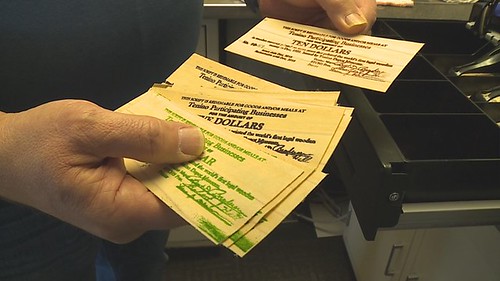
To read the complete article, see:
Why Tenino is still printing wooden money
(https://www.king5.com/article/entertainment/television/programs/evening/tenino-wooden-money/281-424b7e09-292c-4a51-88d5-6bbe5ec414bb)
To read an earlier E-Sylum article, see:
QUIZ ANSWER: THE NUMISMATIC SIGNIFICANCE OF TENINO, WASHINGTON (https://www.coinbooks.org/esylum_v11n50a24.html)

THE WATERGATE BANKNOTES
I missed this when the post was first made in December 2019, but I wanted to call attention to JP Koning's great article on The Watergate banknotes and the not-so-anonymous uses of cash. here's an excerpt, but be sure to read the complete article online. -Editor

Cash isn't quite anonymous, it's anonymous-ish.
To illustrate this, a few years ago I wrote about the 1932 Lindbergh kidnapping case. The ransom was paid in gold certificates, not Federal Reserve notes. By coincidence, the U.S. went off the gold standard the next year, and all gold certificates were called in. So when the kidnapper spent some of his gold certificates in 1934 to buy gas, his purchase was odd enough to out him to the authorities.
I recently stumbled on a more recent example of cash de-anonymization. Most people know the gist of the Watergate scandal, but to recap five burglars were caught breaking into Democratic headquarters at the Watergate building on June 17, 1972.
Who were they and what were they doing there? At first, no one had a clue. But the police did find around $3,600 in cash on them, much of it in sequentially-numbered $100 banknotes. See the serial numbers below:

A series of sequential banknotes meant that the cash had come fresh from the U.S. Bureau of Engraving and Printing, the agency that produces banknotes on behalf of the Federal Reserve. The new notes would have been sent to a bank which in turn distributed the notes in their original sequential order to customers.
The serial numbers of the Watergate notes also gave a geographical sense of where they had been issued. There are 12 regional Federal Reserve Banks. Notes beginning with F are issued into circulation by the Federal Reserve Bank of Atlanta, those beginning with C by the Federal Reserve Bank of Philadelphia.
Two days after the break-in, FBI agents contacted these two district banks for more information. It turns out, Federal Reserve Banks do keep track of banknote serial numbers. The Philadelphia Fed informed agents that the notes in question had been shipped to a private bank, the Girard Bank & Trust in Philadelphia, while the Atlanta Fed had shipped theirs to the Republic National Bank in Miami.
Unfortunately, the two commercial banks did not record the serial numbers of the bills that they had distributed to the public. However, one of the burglars--Bernard Barker--happened to have an account at the Republic National Bank in Miami. (The trail to the Girard Bank & Trust turned cold).
Scanning through Barker's bank information, investigators discovered that several months before five large deposits had been made into his account. This included four checks totaling $80,000 drawn on a Mexico City bank and one for $25,000 from a Miami bank. These funds were eventually traced back to the the Committee to Re-Elect the President, an organization created to help raise funds for Nixon's upcoming election campaign.
And there was a smoking gun. A money trail from the pockets of the Watergate burglars to the President's administration. The burglars, it was further discovered, had been hired by Committee to Re-Elect the President to wire-tap Democrat party phones and photograph documents. So the President was spying on his political enemies.
So.... are any $100 bills with one of these serial numbers now on the numismatic market? Their value would be tough to estimate, but these would be fantastic collectibles, right up there with the Lindbergh and D.B. Cooper notes.
The remainder of the article discusses issues of technology and anonymity related to banknote serial numbers. Is your ATM watching you? -Editor
To read the complete article, see:
The Watergate banknotes (http://jpkoning.blogspot.com/2019/12/the-watergate-banknotes.html)
BANKNOTE OF 2019 NOMINATIONS
The International Bank Note Society nominations for the 2019 Banknote of the Year are available on the group's web site. Below is a list and images of a couple notes that caught my eye. -Editor
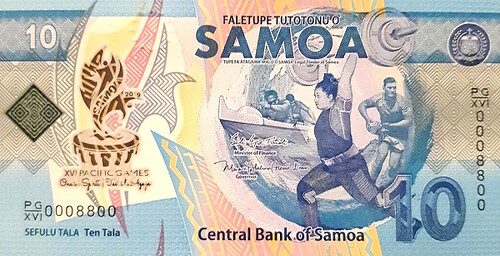
Samoa 10 tala
Albania - 200 leke
Aruba - 100 florin
Australia - 20 dollar
Bahamas - 50 dollar
Cambodia - 15,000 riel
Eastern Caribbean States - 10 dollar
European Union - 200 euro
Gambia - 10 dalasis
Georgia - 10 lari
Hong Kong - 100 dollar (Bank of China)
India - 20 rupees
Kenya - 500 shilling
Macau - 20 petacas
Morroco - 20 dirham
Northern Ireland - 10 pound (Bank of Ireland)
Northern Ireland - 5 pound (Ulster Bank)
Norway - 1,000 kroner
Samoa - 10 tala
Singapore - 20 dollar
Switzerland - 1,000 francs
Trinidad and Tobago - 100 dollar
Ukraine - 100 hryvnia
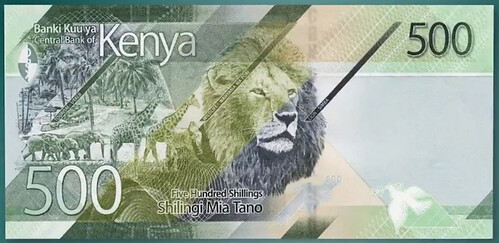
Kenya 500 shillings
To read the complete article, see:
Banknote of 2019 Nominations
(https://www.theibns.org/joomla/index.php?option=com_content&view=article&id=710&catid=13&Itemid=51)

BANKNOTES AND MARIJUANA
Here's a head-scratching pair of articles relating to banknotes and marijuana. -Editor
A Louisiana woman was arrested on drug charges after police determined the $5,000 cash she used to post an inmate's bail had a "strong odor of marijuana."
Authorities began investigating Stormy Lynn Parfait, 33, on Friday, shortly after she showed up at the Ashland jail to pay the bond fee for an inmate being held there on drug charges, the Terrebonne Parish Sheriff's Office said in a statement obtained by news outlets.
After catching a whiff of the cash, a detective searched her car while she was still at the jail and found nearly $40,000 more inside...
To read the complete article, see:
Police jail woman who paid bail with marijuana-scented cash (https://apnews.com/c63d63e0280b74c541632cd0404eee15)
This article on IRS pot industry cash rooms comes from News & Notes Volume V, Number 38, March 10, 2020 from the Society of Paper Money Collectors. -Editor
The marijuana industry is posing a challenge for the IRS, which is having a hard time collecting taxes on transactions in states where medical and recreational use is legal.
During testimony before House lawmakers on Wednesday, Mnuchin said there is fallout from discrepancies that exist between state and federal laws regulating the industry.
"From the IRS' standpoint, this creates a very large concern, and we have to build cash rooms to take in large amounts of cash where people owe us taxes, because we want to collect the taxes and those entities are not banked," Mnuchin said. "And I would say that creates risk to our IRS employees and to the people in the community."
The question came from Democratic Florida Rep. Charlie Crist, who said the state's medical marijuana market is forced to operate in all-cash because of the incongruity between federal and state laws.
The main issue is: The industry remains unbanked because financial institutions are not sure whether doing business will put them in violation of federal finance and anti-money laundering laws even as states legalize cannabis for medical and recreational use.
To read the complete article, see:
IRS tripped up by cash-only pot industry, Mnuchin says
(https://www.foxbusiness.com/politics/irs-tripped-up-by-cash-only-pot-industry-mnuchin-says)
LIBYA'S RIVAL BANKNOTES
Loren Gatch writes:
" I saw that item about Yemen's rival banknotes. Coincidentally, my latest column in Paper Money was about this as well (also about what is happening in Libya, which I think is even weirder)."
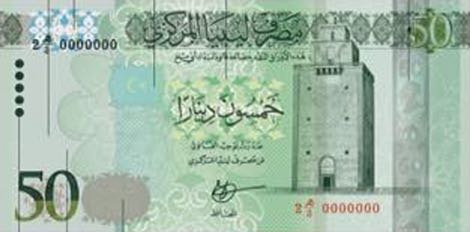
Russian-printed Libya 50-dinar banknote
https://banknotenews.com/?p=5887
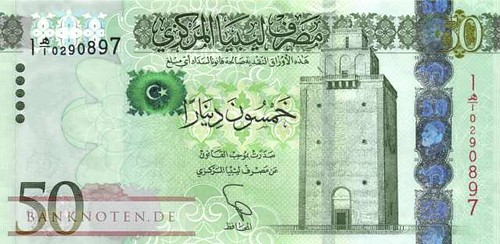
De La Rue-printed Libya 50-dinar banknote
https://www.banknoten.de/product_info.php?info=p55685_libya---50--dinars---080-unc-.html
With permission, we're republishing the section of Loren's article on Libya's rival banknotes. Thanks. -Editor
Unlike Yemen, Libya's divide runs east to west, rather than north to south. Ruled for over forty years with bad-boy flair by Muammar Gaddafi, Libya descended into turmoil after 2011, when the Arab Spring and western interventions led to Gaddafi's overthrow and death. Despite UN attempts to keep the country together, after 2014 political authority in Libya split between a so-called House of Representatives, centered in Tobruk, and a UN-backed Government of National Accord located in Tripoli.
This division of authority is awkward in a fundamental way. Libya's oil fields lie in the east, while the Bank of Libya in Tripoli is the sole authorized recipient of precious hard currency from the country's oil exports. Occupying Tripoli would give the eastern government control over those export receipts as well as access to some $70 billion in foreign exchange reserves. The eastern forces, known as the Libyan National Army, commanded by Khalifa Haftar, have scored military successes in the west and by 2019 threatened to advance towards Tripoli itself.
Haftar's big problem has been finding the funds to pay his troops and pay off his motley militia allies. In addition to support from the Egyptians and the Emiratis (among others), Haftar has financed his operation by creating a parallel banking system, and even a parallel dinar currency, all managed by a renegade branch of the Bank of Libya in the eastern city of Beida.
Libya has been a longstanding customer of De La Rue, the printer of its current banknotes. Yet in 2016, the eastern Bank of Libya began taking delivery of its own supplies of Libyan dinars, printed by Russia's Goznak. By the end of 2018, the Russians had provided over 10 billion dinars' worth of this alternative supply, even as De La Rue continued its own deliveries to the western Bank of Libya. Enforcing an international embargo on the eastern Libyan government, in November 2019 the government of Malta seized a huge transshipment of this unofficial Libyan currency, apparently destined for Haftar, much to Russia's annoyance.
While the two varieties of dinar look similar, they are readily distinguishable by their different watermarks, serial numbers, and other security features. The eastern government is in effect financing its rebellion via a massive counterfeiting operation. Yet it is not at all clear that the government in Tripoli could repudiate this unauthorized currency, even if it wanted to. Doing so at this point might simply create a liquidity crisis for the entire Libyan economy.
As Lincoln once predicted about his own divided nation, "it will become all one thing or all the other." Likewise, in both Yemen and Libya there doesn't seem to be any plausible equilibrium between the opposing sides. Perhaps in some distant future, Libyan dinars and Yemeni rials will persist only as numismatic curios, like the Biafran pound or the Katanganese franc, testaments to failed secessionist aspirations and to the sufferings of the people who used them.
Loren adds:
"The easiest difference to see is the placement of the serial number, which is horizontal on the Russian-printed notes, and uses the same font size throughout the run of the number. The Libyan Central Bank's dinar notes have a vertical serial number, with ascending font size."
Loren pointed me to images of the notes online. Thanks! -Editor
To read the earlier E-Sylum article, see:
YEMEN'S RIVAL BANKNOTES (https://www.coinbooks.org/v23/esylum_v23n10a25.html)
DON'T USE MICROWAVE TO DISINFECT BANKNOTES

Now that Covid-19 is a pandemic, how far would you go to disinfect your items?
A man has previously attempted to disinfect his Singapore dollar notes by washing them with soap.
On Wednesday (11 Mar), China news-in-English website Shanghaiist reported that a South Korean man from Busan thought of another "good" way to disinfect his money — heating it in a microwave.
The man gathered a total of 39 pieces of 10,000 won notes — amounting to around S$450 — then placed them inside a microwave.
Once he turned on the device, he was surprised to find that the banknotes were smoking.
Prior to the man's attempt, a Chinese auntie from Jiangsu province burnt thousands of yuan after placing her money in a microwave for disinfection, reported The Independent.
The woman — also known as "Aunt Li" — was concerned because the banknotes could've been touched by people infected with Covid-19.
After less than 1 minute in the oven, the money was burnt to a crisp.
To read the complete article, see:
South Korean Man Heats Banknotes In Microwave To Disinfect Them, But His Plans Go Up In Smoke
(https://mustsharenews.com/disinfect-microwave-banknotes/)
THE FEAR OF VIRUS-TAINTED DOLLARS
This Bloomberg article discusses how the fear of virus-tainted cash could boost the use of electronic payments. -Editor
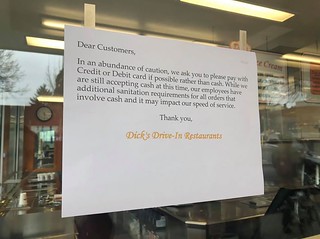 The signs began appearing around Seattle in the windows of Dick's Drive-In, the city's iconic burger chain: "In an abundance of caution, we ask you to please pay with credit or debit card
if possible rather than cash."
The signs began appearing around Seattle in the windows of Dick's Drive-In, the city's iconic burger chain: "In an abundance of caution, we ask you to please pay with credit or debit card
if possible rather than cash."
Fear of dollars is now palpable in the U.S. epicenter of the coronavirus.
And across the financial industry, a rigorous debate is brewing over how to address the public's mounting concern that greenbacks might transmit Covid-19. Studies show it's at least theoretically possible for other coronaviruses to survive on the dollar's cotton-and-linen weave, though there's little agreement on the actual risk of contagion.
Behind the scenes, some industry groups and banks have been urging the Federal Reserve and Treasury Department to issue a statement assuring Americans that there's minimal risk for using cash, according to people with knowledge of the discussions. The Fed, in turn, says it's waiting for advice from the Centers for Disease Control and Prevention, which so far has said the virus spreads primarily through person-to-person contact. In the meantime, the Fed has been putting notes repatriated from Asia in quarantine for up to 10 days to ensure it's safe.
The stakes are high for banks and companies handling electronic payments: Billions of dollars in profits hinge on whatever statement or policy authorities ultimately issue.
The virus may end up serving as a "trigger event" for wider acceptance of cards long term, either persuading retailers to start taking them or prompting the government to force them, said Lisa Ellis, an analyst independent research boutique MoffettNathanson. The shift would be especially dramatic in regions of the world where card use is still relatively uncommon, she said.
"Digital payments are already viewed as good for society by governments because they help with financial inclusion, they drive tax revenue and eliminate corruption," she said. "This is another reason: ‘Oh, and it's hygienic too.'
Despite the increased popularity of credit and debit cards in recent years, cash still remains one of the most popular ways to pay for things in the U.S., accounting for 26% of all payments by consumers last year, according to data compiled by the Fed. Spare change and dollar bills are still overwhelmingly favored for small purchases, accounting for about 50% of payments under $10.
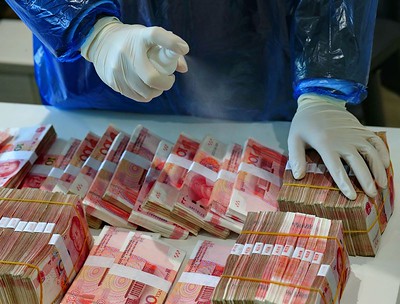
A clerk disinfects banknotes in Suining, China
To read the complete article, see:
Fear of Virus-Tainted Dollars Opens New Front in War on Cash
(https://www.bloomberg.com/news/articles/2020-03-11/fear-of-virus-tainted-dollars-opens-new-front-in-war-on-cash)
FLORENCE NIGHTINGALE BANKNOTE LAMP ERROR
It's hard to get historical scenes right, and sometime inaccurate depictions find their way onto coins and banknotes. Here's an article about a problem with Florence Nightingale's lamp found via News & Notes Volume V, Number 38, March 10, 2020 from the Society of Paper Money Collectors. -Editor

The £10 note which was in circulation for nearly 20 years featured Florence Nightingale holding the wrong lamp.
Nightingale, dubbed ‘The Lady with the Lamp' during the Crimean War, was featured on a commemorative banknote in circulation between 1975 and 1994. At their peak in 1990 there were almost 600 million of the notes in circulation.
Her standing portrait on the reverse of the £10 note is accompanied with a background scene from the Scutari hospital where she served in Turkey.
At the centre of the picture, rays of light shine from the lamp Nightingale holds while she and other nurses tend to patients.
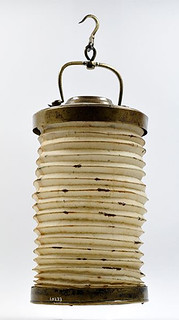 The lamp on the note is a genie-style lamp that holds a candle, but Nightingale used the more elaborate and distinctive folded Turkish ‘fanoos' lamp.
The lamp on the note is a genie-style lamp that holds a candle, but Nightingale used the more elaborate and distinctive folded Turkish ‘fanoos' lamp.
David Green, the Florence Nightingale Museum director, said: "There were journalists sent over in the Crimean War but no photographers, so when they described the woman walking around the ward, none of them described the lamp."
During the Crimean War, The Times reported on Nightingale walking around the beds of wounded men throughout the night, holding a lamp aloft before her.
Yet the precise outline of the lantern light used to care for the wounded and dying soldiers was never specified.
It is often the historically inaccurate Grecian lamp or genie lamp, as opposed to the folding Turkish lamp.
Of the erroneous 1975 banknote, Mr Green said: "It's a piece of history you can carry around in your pocket, and it also shows you how accuracy is important."
The banknote will feature in the upcoming exhibition ‘Nightingale and Popular Fiction', which will be displayed at the museum.
The exhibition objects are being taken out of the museum's storage or sourced from other institutions.
The museum is constructing a giant version of Nightingale's fanoos lamp for a tourist photo opportunity.
Nightingale was the first woman to appear on a banknote, excluding the female monarchs, and remained the only woman immortalised on paper currency until 2002.
The Bank of England commissioned new designs for the four polymer notes, which began to enter circulation in 2016.
The article surprisingly did not picture Nightingale's lamp, but I found and added an image of it from the Florence Nightingale Museum in a Smithsonian magazine article (linked below). -Editor
To read the complete article, see:
Shining a light on £10 Florence Nightingale banknote lamp blunder
(https://www.swlondoner.co.uk/shine-a-light-lamp-blunder-on-10-florence-nightingale-banknote/)
To read the Smithsonian magazine article, see: Celebrate Florence Nightingale's 200th Birthday With Exhibit Featuring Her Famed Lamp, Pet Owl (https://www.smithsonianmag.com/smart-news/exhibition-celebrates-florence-nightingale-through-200-objectsincluding-her-famed-lamp-180974357/)
BITCOIN PROPAGANDA ART
An artist and bitcoin fan has created a series of works promoting the crypto currency. Also found via News & Notes Volume V, Number 38, March 10, 2020 from the Society of Paper Money Collectors. -Editor
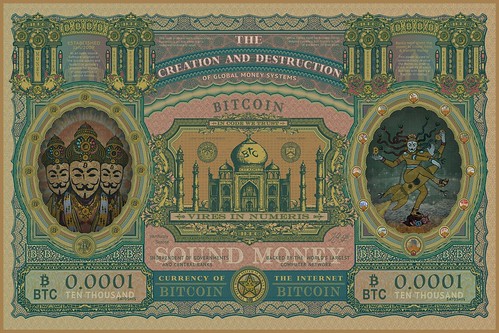
"The Creation and Destruction of Global Money Systems" by Lucho Poletti
It's in this climate that it is now both edgy and eye-raisingly self-aware to brand art as propaganda. In this relatively post-truth world that we live in, everything can feel like propaganda. Poletti is playing with this. And if everyone is biased, potentially, the most honest thing someone can do is be upfront about how their agenda creates a bias.
"On the outside, people who aren't interested in Bitcoin won't get it," Poletti told Bitcoin Magazine. "It's glorifying Bitcoin and putting down paper money."
In college, Poletti studied finance, eventually earning his master's degree. After subsequent years of toil as a financial engineer and analyst, he fell down the Bitcoin rabbit hole in 2013. Despite it not being his life passion, Poletti's background in finance drove him to learn everything he could about how this new, alternative money system actually worked.
Simultaneously, Poletti was still focusing on art, creating pieces that told truth about large-scale societal problems such as how big brands, mainstream media and institutional banks in the financial system manipulate public opinion. Though he felt this work conveyed the thorny truth, he was also aware that it was incomplete because it did not provide an answer other than that the world was brainwashed. By first learning about it, then believing in it, Bitcoin provided that answer.
He lumps his current work into one of two buckets: art for the "masses" that teaches people about the problems with central banking and the benefits of Bitcoin (such as "Dr. Satoshi's Orange Pill," which has been translated into 10 different languages) and art for Bitcoiners who have already "drank the Kool-Aid" and enjoy it as a symbolic testament to the more optimistic and free future they see coming over the horizon.
To read the complete article, see:
How Propaganda Art Can Spread The Message Of Bitcoin
(https://bitcoinmagazine.com/articles/how-propaganda-art-can-spread-the-message-of-bitcoin)
LOOSE CHANGE: MARCH 15, 2020
Here are some additional items in the media this week that may be of interest. -Editor
Eyam's Black Death Coins
The Washington Post article shows how coins helped one town live thorough the Black Death. -Editor

A visitor places a coin on Eyam's boundary stone.
It was called the Black Death. And it was far deadlier than coronavirus.
As governments around the world impose quarantines to prevent the spread of covid-19, it is worth remembering the extraordinary story of Eyam, England, the Derbyshire village that faced an outbreak of the bubonic plague in the 17th century.
A quarantine cordon was established with a one-mile radius marked by a ring of stones. For 14 months nobody went in or out of the village. Food was left at the boundary stone by nearby townspeople in exchange for gold coins submerged in vinegar, which villagers believed would disinfect them. The death-rate skyrocketed.
During its seclusion, Eyam suffered. Bodies piled up; families were instructed to bury their own dead on the outskirts of town.
In all, 260 of Eyam's estimated 800 residents perished during the quarantine, more than double the mortality rate of the Great Plague of London. But Mompesson and the villagers' self-sacrifice had worked. The plague never spread to nearby towns and, 14 months later, in November 1667, the quarantine was lifted.
To read the complete article, see:
Bubonic plague was so deadly an English village quarantined itself to save others
(https://www.washingtonpost.com/history/2020/03/02/bubonic-plague-coronavirus-quarantine-eyam-england/)
The Infectious Pestilence Did Reign
For bibliophiles and anyone killing time in self-quarantine, here's a great Slate article about how the plague ravaged William Shakespeare's world and inspired his work. -Editor
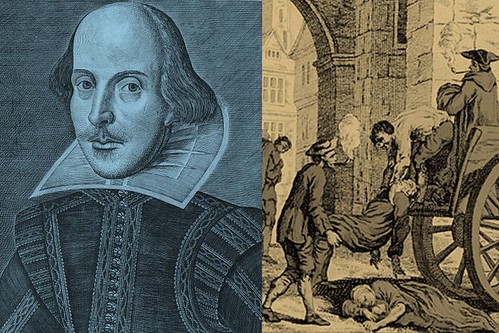
Why didn't Friar John deliver Friar Laurence's letter to Romeo? Because he's stuck in quarantine. Romeo and Juliet are star-crossed once they're indirectly plague-stricken. The plague is the plot twist that turns the most famous love story ever told into a tragedy.
This exchange is over before most kids reading in high school realize what happened. And yet the whole play turns on this one scene. You might be wondering how the plague could be pulling the strings of Romeo and Juliet, and you might not have known until this very moment. As it turns out, that was the point. Shakespeare was being purposefully obtuse. He wrote in veiled language because the subtext would have been obvious back then. He didn't have to belabor the point. Mentioning the plague was the Shakespearean equivalent of ending a tweet with "Sad!" There was no need for any sort of further explanation. "It was omnipresent," says Columbia University professor James Shapiro. "Everybody at the time would have known exactly what those one or two lines meant."
To read the complete article, see:
The Infectious Pestilence Did Reign
(https://slate.com/culture/2020/03/shakespeare-plague-influence-hot-hand-ben-cohen.html)
COINS AND HEALTH
David Pickup offers these health-related notes and says, "Keep well." Thanks. -Editor
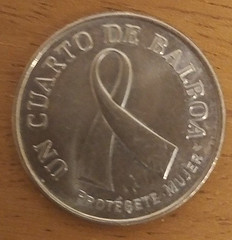 Coins and Health
Coins and Health
If you are self-isolating because of the pandemic, here is a health-related coin. It is from Panama and is a 1/4 cuarto de balboa 2008. The inscription is protegete mujer, which means
"protect yourself, woman" and is about breast cancer awareness.
Are there any health issues with coins?
There was a story in 2014 about Royal Mint issuing coins clad in nickel. Instead of the copper-nickel alloy that had been used since 1947, new 5p and 10p pieces were made from steel and coated with a
layer of nickel. However, some people suffer from a nickel allergy which may have caused a rash.
You should wash your hands if you handle cash
In the Middle Ages a lot of people were killed as a result of coins – they were executed for counterfeiting them.
It is dangerous to swallow coins unless they are made of chocolate. If you do swallow one call a doctor for advice. Do not wait until you go to the toilet to see if there is any change.
FEATURED WEB PAGE: CHINESE COINS AND MEDICINE
This week's Featured Web Page is on "Chinese Coins and Traditional Chinese Medicine."Chinese Coins and Traditional Chinese Medicine Old Chinese "cash coins", which are round copper or bronze coins with a square hole in the middle surrounded by four Chinese characters, served as the major form of currency in China for two thousand years.
It is less well known, however, that Chinese cash coins are believed to have curative powers and have historically played a role in traditional Chinese medicine (TCM). Old cash coins have been used in two ways. One was to have the patient boil the coins in water and then drink the decoction as a form of medicine. The second use was for the Chinese doctor to use a cash coin as a medical tool or instrument to "scrape" the skin along acupuncture meridians to force an illness to move and dissipate.
The following is an introduction to these two uses of old Chinese cash coins in traditional Chinese medicine.
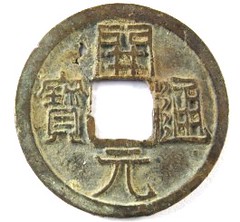
http://primaltrek.com/chinesemedicine.html

